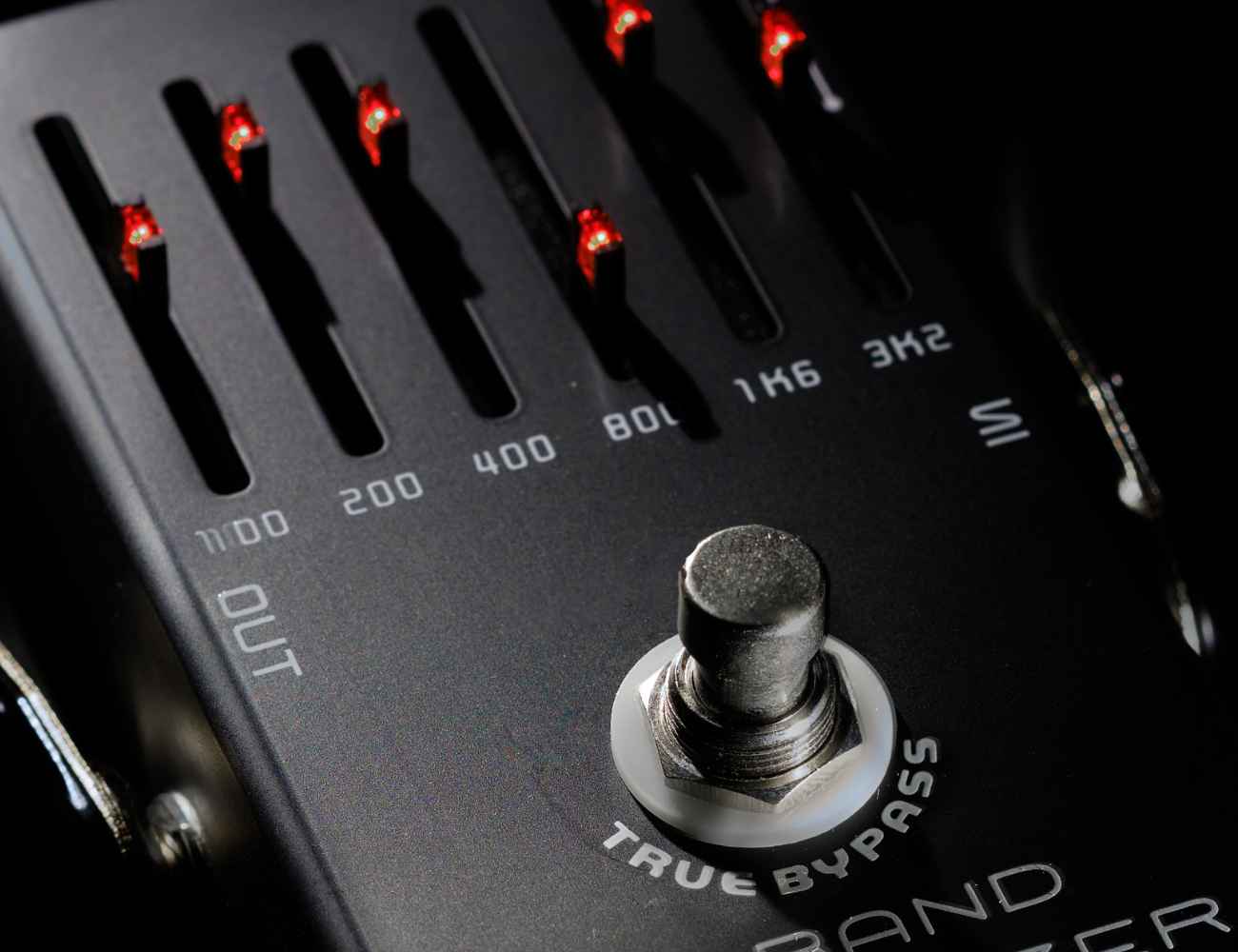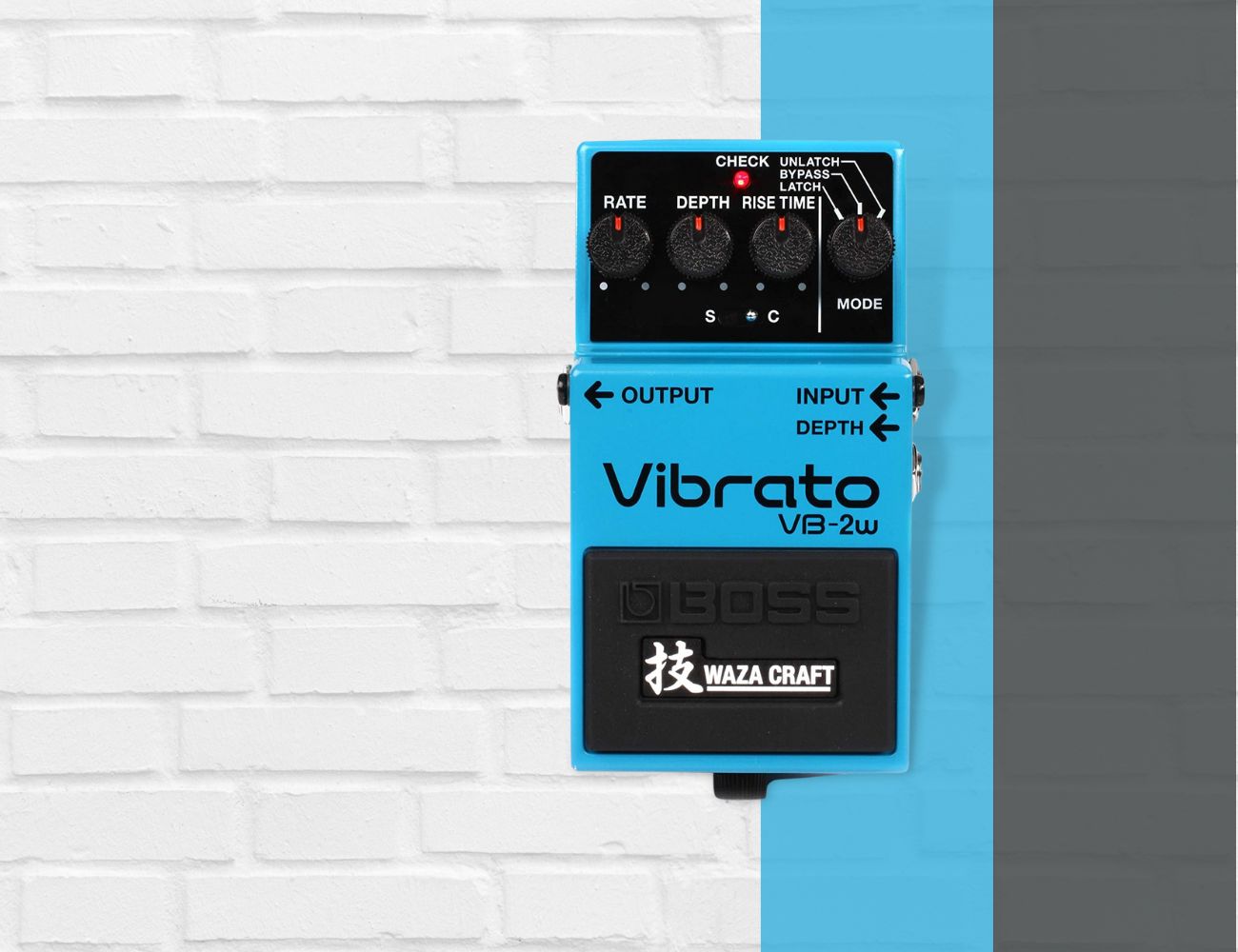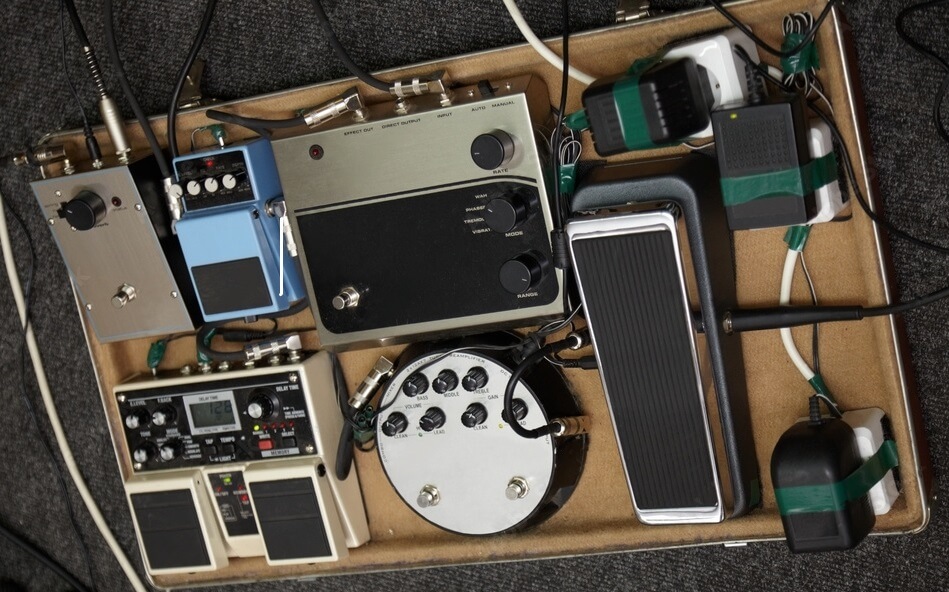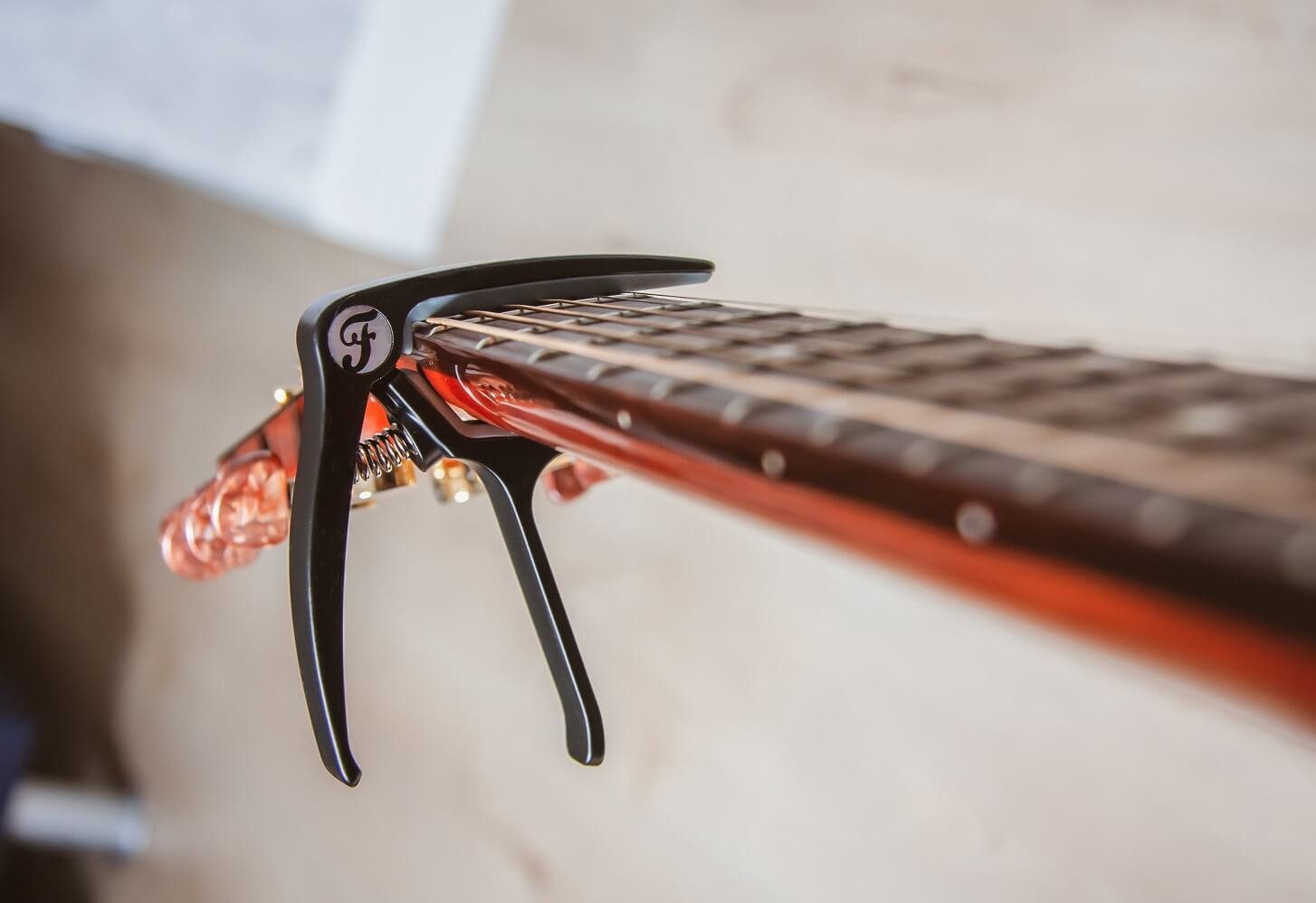Ever find your guitar tone sounding flat or lifeless? The solution might be in a little magic box: an EQ pedal.
Yes, the very tool that can transform your mediocre sound into sonic bliss.
Let’s face it, with the plethora of guitar gear flooding the market, finding the best EQ pedals can be an uphill task.
This guide is designed to bring you clarity amidst the chaos.
We’ll dive into the vibrant world of EQ pedals, explore their functionality, and review top picks that can push your tone from drab to fab.
By the end, you will be well-versed in the importance of these unsung heroes and have a curated list of the best options tailored to various needs and budgets.
Table of Contents
- Best EQ Pedals
- Boss GE-7 7-Band EQ Pedal
- EarthQuaker Devices Tone Job V2 EQ and Boost Pedal
- JHS Haunting Mids Sweepable Midrange EQ Guitar Pedal
- Xotic EP Booster Mini EQ Effect Pedal
- MXR Ten Band EQ Guitar Effects Pedal
- MXR Six Band EQ Guitar Effects Pedal
- Orange Two Stroke Active Dual-Parametric EQ/Boost Pedal
- EX 7 Band EQ Equalizer Mini Guitar Pedal
- Caline 10 Band EQ Guitar Pedal
- Jackson Audio Prism EQ and Boost Guitar Effects Pedal
- VSN 5-Band Guitar EQ Pedal
- JOYO JF-11 6-Band EQ Pedal
- Dunlop EQ Effects Pedal
- SONICAKE Equalizer Guitar Effects Pedal
- Digitech EQ Effects Pedal
- J. Rockett Audio Designs Q Series 6-Band EQ Guitar Pedal
- Aguilar Tone Hammer Bass EQ Effect Pedal
- What exactly is an EQ pedal?
- What to consider when choosing an EQ pedal?
- How to properly use an EQ pedal?
- – Familiarize yourself with the controls and features
- – Adjust the parameters to suit your musical goals
- – Incorporate the EQ pedal into your signal chain
- – Experiment with different EQ settings
- – Understand the impact of the EQ pedal on your tone
- – Learn when to engage and disengage the pedal
- – Regularly maintain and clean it to ensure optimal functionality
- How to order pedals on a pedalboard?
- Boutique vs. Mass-Produced pedals
- How much should you spend on a guitar pedal?
- Can you use a guitar pedal with a bass guitar?
- How to properly power your pedals?
Best EQ Pedals
Before I begin, here are my top selected choices:
MXR Ten Band EQ Guitar Effects Pedal

MXR Ten Band EQ: Tune your sound with ultimate tone-sculpting ability. Check Price
|
|
EX 7 Band EQ Equalizer Mini Guitar Pedal

Powerful analog circuitry in a mini pedal for versatile tonal control. Check Price
|
Boss GE-7 7-Band EQ Pedal
Legendary BOSS quality for guitarists, with 7-band EQ.
BOSS provides the ultimate tools for guitarists, offering legendary quality and performance. Their products are designed to deliver professional sound and quality, giving guitarists the tools to create and perform their best music.
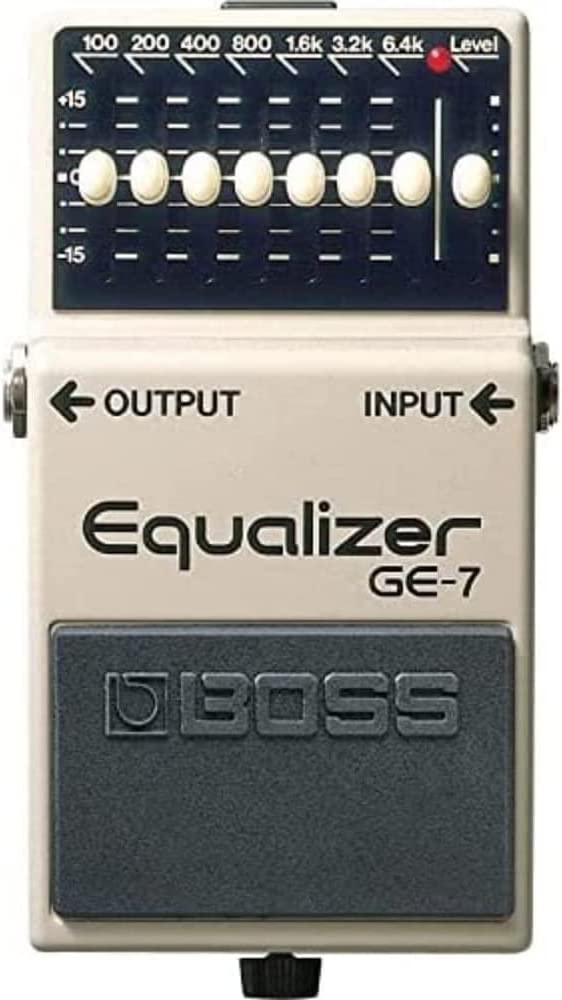
Originating from the esteemed brand BOSS, the GE-7 is a multi-colored EQ guitar pedal fashioned in a durable, compact design.
This pedal is a testament to the consistent quality BOSS has provided guitarists since its inception in 1973.
As a result, the GE-7 is a fantastic tool in any guitarist’s repertoire, whether on stage, in the studio, or just jamming at home.
It sports seven bands, allowing for a broad scope of sound manipulation.
Moreover, it’s a stompbox-style pedal known for its simplicity and ease of use.
It can handle anything from providing a clean boost for acoustic solos to creating intriguing distortion effects for an electric guitar.
It’s also lightweight, weighing in at just 0.45 kilograms.
The dimensions are practical, measuring 6 x 3.7 x 2.65 inches, thus occupying minimal space on your pedalboard.
- My Review
Stepping on the GE-7 from BOSS is like wielding a painter’s brush loaded with a whole spectrum of colors.
From crisp, delicate tones to rich and powerful soundscapes, this EQ pedal allows you to shape your sonic canvas.
It’s a tool that adapts to your unique style, transforming your music into genuine art.
This robust EQ pedal controls seven frequency bands ranging from 100 Hz to 6.4 kHz. Each band has a level control that moves smoothly for precision adjustments.
You can see these as the different shades in your sonic palette, each capable of adding its touch to the overall sound.
The BOSS GE-7 packs a punch for volume control for a tiny pedal.
Using it to boost solos or make your guitar stand out in a mix was an absolute pleasure.
On the flip side, it’s also great for trimming out any unruly frequencies that might throw off your sound balance.
But even the brightest diamond isn’t without its flaws.
I’ve noticed a slight hissing noise when the slider levels are pushed high.
While this isn’t noticeable in a full band mix or live setting, it could distract solo practice or in quieter environments.
Design-wise, the stompbox-style and rugged construction scream durability.
This pedal was built to withstand the rigors of live performances and the inevitable accidents in a busy studio.
Its compact dimensions mean it fits snugly onto any pedalboard, leaving room for other essential effects.
Here are the ratings I’ll give to the Boss GE-7 7-Band EQ Pedal:
The BOSS GE- overall-7 is an EQ pedal that breathes life into your guitar tone.
For intimate solo performances or loud, booming gigs, the GE-7 helps you create your sonic identity, one strum at a time.
- Pros:
- Durable and well-built
- Versatile for different guitar tones
- Can clean up or boost your sound
- Compact size for pedalboards with limited space
- Helps cut through the mix and shape frequencies
- Cons:
- Potential hiss on high gain channels
- Slight quality loss with drastic EQ variances
- Some units may have noise issues
- Not necessary if your amp already has EQ controls
- May require additional noise reduction pedal
My final verdict is that the Boss GE-7 7-band EQ Pedal is a highly recommended product.
Its durable build, versatile functionality, and ability to enhance tone and shape frequencies make it a valuable tool for guitarists.
While there are minor concerns, such as potential hiss and quality loss with drastic EQ variances, overall, the positive reviews outweigh the negatives.
The trusted brand reputation of BOSS and the pedal’s value for its price further solidify its appeal.
If you’re looking to fine-tune your guitar sound, the Boss GE-7 EQ Pedal is worth considering.
EarthQuaker Devices Tone Job V2 EQ and Boost Pedal
Compact EQ & Boost pedal with full frequency response.
EarthQuaker Devices Tone Job V2 provides full frequency response from a range of instruments with its level, treble, bass, and mid controls. Ideal for boosting and shaping tones, this pedal is designed to make sonic exploration and aural innovation easier than ever.
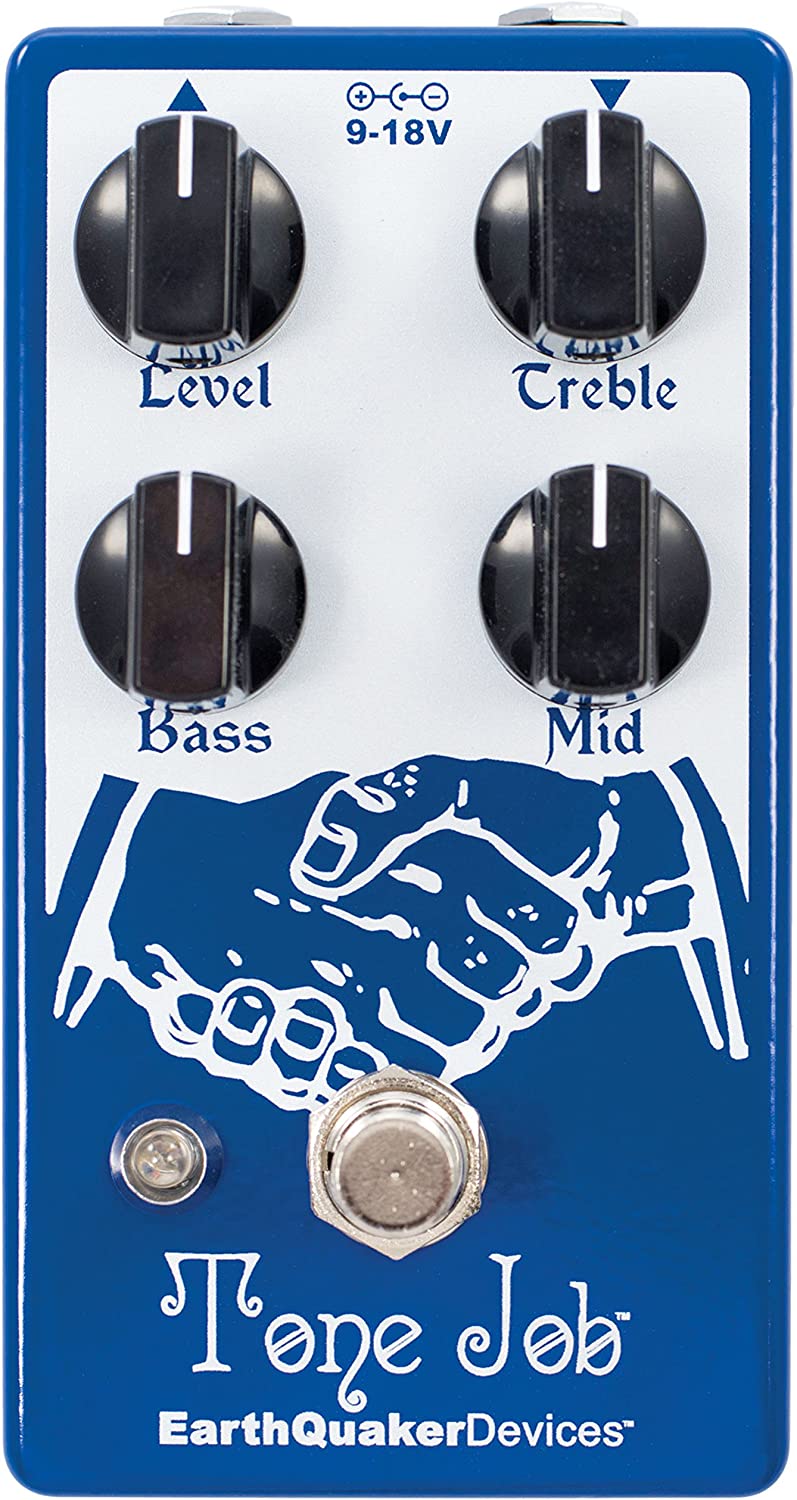
Produced by Earthquaker Devices, the Tone Job V2 is an EQ and Boost Pedal with a stylish, multicolored design.
This versatile gadget, measuring approximately 5.65 x 3.35 x 3.2 inches, is compatible with any device operating at 9 volts.
It’s much more than a typical guitar pedal; it also works well with bass guitars, synthesizers, and other musical instruments, handling an extensive range of frequencies.
With controls for treble, bass, and middle, you can cut or boost up to 20dB, shaping your tone as you wish.
Plus, a level control boosts your signal up to five times the input post-EQ.
It’s a fine-tuning tool that helps to breathe new life into your sound.
Its simple, user-friendly design is grounded in Earthquaker Devices’ philosophy of creating reliable, musically sound effects pedals.
- My Review
Diving into the world of sound enhancement with the EarthQuaker Devices Tone Job V2 EQ and Boost Pedal, you’re met with a delightful splash of colorful versatility.
This tool gives you the power to control your audio realm, making it perfect for the musical adventurer in you.
You’ve got a stereo preamp at your disposal, designed to embrace a wide band of frequencies.
It’s not just for your standard electric guitar – it plays well with bass guitars, synthesizers, and anything else you fancy plugging in.
This nifty piece of kit allows you to tweak the treble, bass, and middle, with the option to cut or boost by up to 20 dB.
So, like a seasoned chef, you get to fine-tune the taste of your sonic cuisine.
But here’s where it sings – the level control.
Boosting your signal post-EQ can give you up to five times the input, depending on your dial setting.
Picture yourself at the helm of a powerful spaceship, accelerating through the cosmos of sound – that’s the feeling it gives you.
Yet, it’s not just about power.
The design of this pedal is like a well-tailored suit tailored to fit your musical endeavors.
It’s simple, user-friendly, and practical without losing its innovative edge.
EarthQuaker Devices have built this pedal with the utmost quality, offering a lifetime guarantee.
However, it’s not without its quirks.
For example, the unity gain sits around 10 o’clock, perhaps somewhat unconventional for some.
Also, the controls can feel hypersensitive, like a race car ready to bolt at the slightest touch.
Yet, these could be seen as features rather than bugs, offering you room for significant boosts and nuanced control.
Here are the ratings I’ll give to the EarthQuaker Devices Tone Job V2 EQ and Boost Pedal:
In the vibrant landscape of audio equipment, the EarthQuaker Devices Tone Job V2 EQ and Boost Pedal stand out as versatile, robust, and reliable companions on your musical journey.
With it, you’re not just playing music; you’re painting with sound.
- Pros:
- Wide frequency range for various instruments
- Boosts signal up to 5 times
- Compact and user-friendly design
- Useful for fine-tuning tone and enhancing dynamics
- Works well with limited onboard tone controls
- Cons:
- Unity gain at around 10 o’clock
- EQ controls may be more sensitive than needed
- Some users experienced noise issues
- Boost feature may not provide enough gain
- Limited customer support responsiveness
My final verdict is that the EarthQuaker Devices Tone Job V2 EQ and Boost Pedal is a solid choice for musicians looking to enhance their tone and fine-tune their sound.
Its wide frequency range, versatile EQ controls, and boost feature offer great versatility and functionality.
The pedal’s performance is generally well-regarded, although some users have reported noise issues.
The EarthQuaker Devices brand is known for producing high-quality pedals, and the Tone Job is no exception.
Considering its features and performance, it offers good value for its price.
Overall, the EarthQuaker Devices Tone Job V2 EQ and Boost Pedal is a reliable tool that can breathe new life into your sound and earn a spot on your pedalboard.
JHS Haunting Mids Sweepable Midrange EQ Guitar Pedal
Scare up great tone with JHS Pedals’ Haunting Mids EQ.
The JHS Pedals Haunting Mids offers frightfully effective Sweepable-Mids EQ Preamp control to boost or scoop mid frequencies, helping guitarists find the tone that haunts their imagination. The Volume, Mids, Sweep, and Lo/Hi toggle knobs offer a range of options to craft the perfect sound.
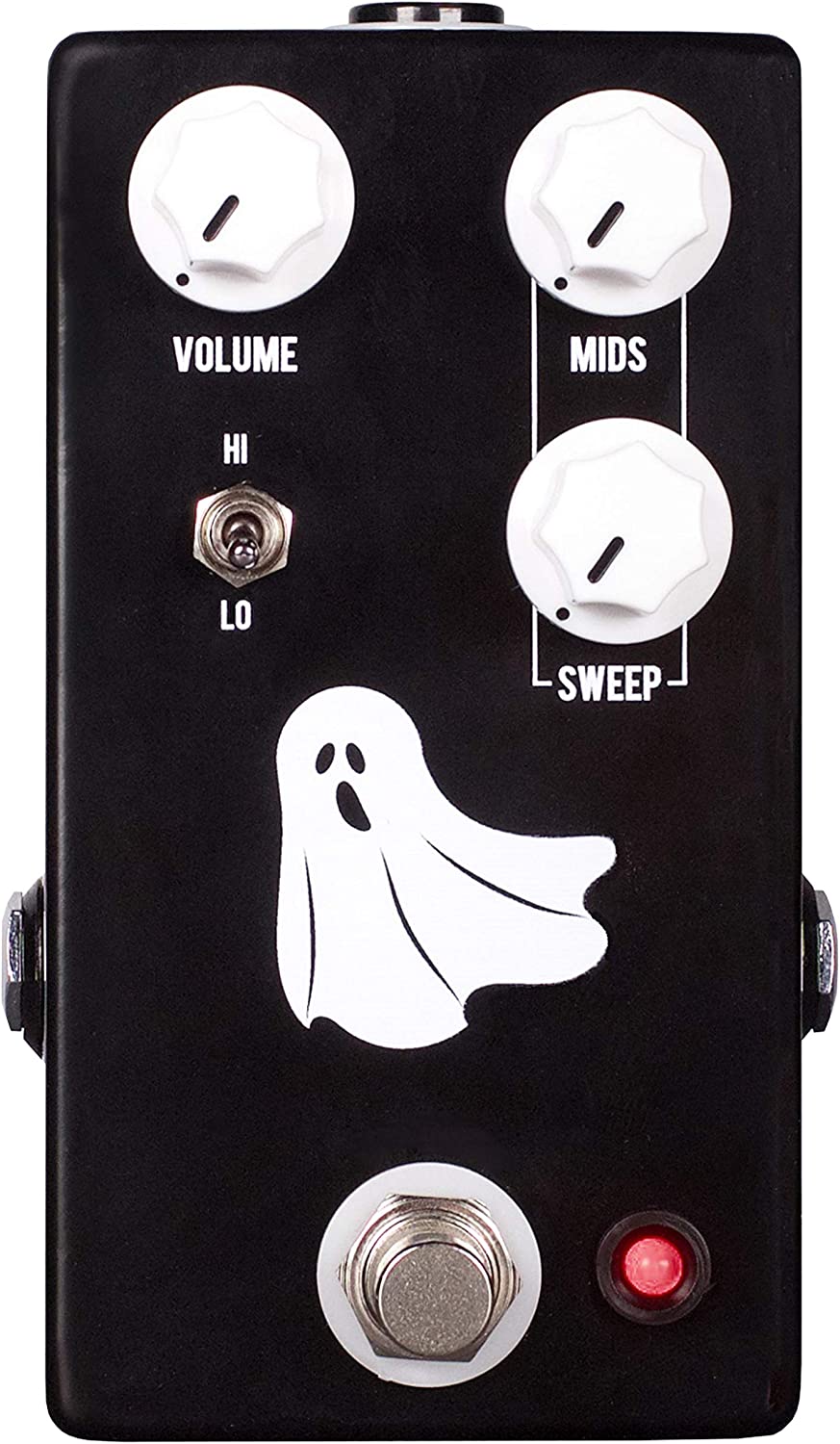
This handy little gadget, the JHS Haunting Mids EQ Guitar Pedal, delivers impressive versatility and control over your guitar’s tone.
Its primary purpose is to allow musicians to enhance or suppress midrange frequencies, hence its name, “Haunting Mids.” This capability is especially useful when aiming to slice through dense sonic mixes.
Equipped with a sweepable midrange frequency feature, the pedal offers a range from 400Hz to 7.5kHz, which provides a vast playground for finding your perfect EQ.
Additionally, the device can deliver up to a 10dB boost when the EQ is flat.
Compact and robustly built, it sports a white chassis with a dimension profile of 6 x 7 x 10 inches and weighs a mere 0.29 kilograms.
Powered by a standard 9V DC negative source, it’s relatively energy efficient, consuming only 13mA.
Perhaps what’s most striking is its intuitive design.
It houses Volume, Mids, and Sweep controls, alongside a Lo/Hi toggle to manage the ‘Q’ factor, giving users precise influence over their sound.
- My Review
Stepping into the world of sound with the JHS Haunting Mids EQ Guitar Pedal felt like I was handed the reins of a sonic stallion, granting me greater control over my musical output than I’d ever had.
Moreover, There’s something remarkably empowering about having this command level over midrange frequencies – it’s like being an audio alchemist.
Its capability to enhance or mute midrange frequencies is akin to owning a sonic scalpel, capable of making those minute incisions in a mix that can transform an okay performance into an unforgettable one.
Plus, the sweepable midrange frequency, adjustable from 400Hz to 7.5kHz, opens Pandora’s box of tonal possibilities, offering a wide array of tones.
It’s almost as if JHS Pedals bestowed upon us the golden key to the city of tone.
The 10dB boost when the EQ is flat indeed comes in handy when you want to add that extra punch to your sound.
Yet, I found the real cherry on top to be the intuitive design of the pedal, making it an absolute breeze to use.
Though lightweight and compact, the pedal has a solid build, with a white color that adds a certain aesthetic appeal.
However, a minor bone to pick would be the lack of a dedicated Q-knob, replaced by a Hi/Lo toggle instead.
A dedicated Q knob would have allowed even finer adjustments, but it’s a small trade-off considering the overall quality of the pedal.
A minor power consumer, the pedal runs on a 9V DC negative source and uses only 13mA.
Here are the ratings I’ll give to the JHS Haunting Mids Sweepable Midrange EQ Guitar Pedal:
JHS Pedals’ Haunting Mids is a tool crafted for the discerning musician, enabling a mastery over tone that’s hard to come by on other devices.
An experience well worth the investment.
- Pros:
- Simple and effective midrange EQ.
- Offers sweepable midrange frequency.
- +10dB boost with EQ flat.
- Wide range of sweepable center frequencies.
- Easy to use and find desired tone.
- Cons:
- Lacks a dedicated Q-knob for adjusting Q-factors.
- No frequency indications on the sweep knob.
My final verdict is that the JHS Haunting Mids Sweepable Midrange EQ Guitar Effects Pedal is a highly capable and versatile pedal that offers effective midrange EQ control.
Its sweepable midrange frequency and +10dB boost capability allow users to find their desired tone and cut through any mix.
The pedal’s high-quality construction, ease of use, and compact size add to its appeal.
While no negative reviews are available to highlight any drawbacks, the lack of a dedicated Q-knob and frequency indications on the sweep knob could be potential areas for improvement.
Considering its features, performance, brand reputation, and value, the JHS Haunting Mids pedal is a solid choice for guitarists seeking to shape their midrange frequencies effectively.
Xotic EP Booster Mini EQ Effect Pedal
Classic tone with versatile boost and extra sparkle.
The Xotic EP Booster is a preamp pedal designed to provide up to 20dB of gain and shimmering boost tone. It features two internal DIP switches to customize the sound, with a Bass Boost and Bright switch for added versatility. Ideal for adding some extra edge or shimmer to darker sounding instruments.
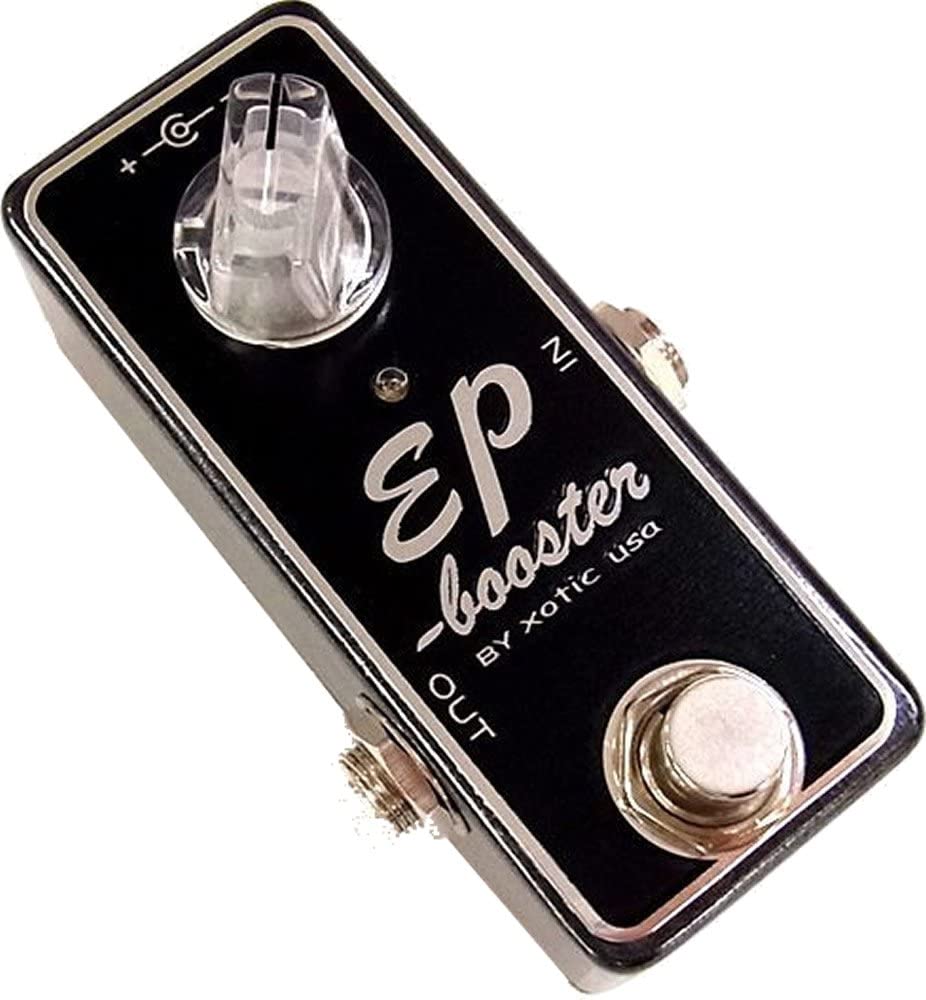
In musical accessories, the Xotic EP Booster Mini EQ Effect Pedal is a distinguished player known for its ability to refine and elevate the tones of your guitar.
Housed in a classic black casing, the device is elegantly compact, measuring 5.6 x 3.2 x 2.8 inches and weighing less than a pound.
Inside, it features a discrete FET preamp and boasts two internal DIP switches, one for bass boost and the other for bright.
This means you can tailor the boost to your preferred sound.
Additionally, it’s worth noting that the pedal can provide up to +20db of gain.
With operation ranging between 9-18vdc, it offers a versatile range for your musical needs.
Its design has been inspired by the iconic Echoplex preamp, renowned for generating a sparkling boost tone.
This pedal is excellent at giving your darker-sounding instruments a shimmering edge and ensuring single coils keep up with the right touch of low end.
In addition, you’ll appreciate its transparent full-frequency boost, which beautifully replicates the input it receives.
- My Review
The Xotic EP Booster Mini EQ Effect Pedal feels like unearthing a gem when you get your hands on this little wonder.
Its compact size, tipping the scale at less than a pound, seems almost deceptive, but that’s where you’re caught off guard.
It’s like having a lion in a kitten’s body – small but ferocious!
Twisting the knob, the device breathes life into the quietest of notes, elevating their voice and allowing them to sing loud and clear.
In addition, you get a pretty impressive gain boost of up to +20db, which, trust me, is nothing short of a powerhouse performance.
And it doesn’t stop there.
With the option to toggle between 9-18vdc, versatility becomes its middle name.
Now, let’s delve into the tone.
In a world full of clones, this pedal stands out like a lighthouse at night, guiding your guitar to the shores of audial brilliance.
It’s not just about making your guitar louder, it’s about making it shine, adding that sparkle that turns an average performance into an unforgettable one.
If your instrument is the artist, consider the Xotic EP Booster Mini the canvas, enhancing every stroke with a touch of elegance.
Yet, as beautiful as it is, there’s a slight caveat – the lack of an output volume control.
Given the boost this pedal provides, it could create some imbalance in mixing levels.
But let’s be fair, in the grand symphony of what the Xotic EP Booster Mini EQ Effect Pedal achieves, this seems like a minor gripe, a small cloud on an otherwise sunny day.
So there you have it, my journey with this pedal has been quite the ride, a musical adventure filled with pleasant surprises and just a minor bump or two.
Here are the ratings I’ll give to the Xotic EP Booster Mini EQ Effect Pedal:
Would I recommend it? Absolutely. It’s not perfect, but then again, what is?
It offers a chance to enhance your music; sometimes, that’s all we need.
- Pros:
- Warm, sparkling boost tone
- Customizable with internal switches
- Versatile and enhances lead playing
- High-quality build and durable
- Improves thin-sounding single coils
- Cons:
- May color the sound and not transparent
- Some experience added noise
- Not suitable for every tone or setup
My final verdict is that the Xotic EP Booster Mini EQ Effect Pedal is a highly versatile and feature-rich pedal that delivers a warm, sparkling boost tone.
Its customizable options and high-quality build enhance the performance of thin-sounding single coils and add dimension to clean tones.
While it may not be completely transparent, and some users experience added noise, overall, it offers excellent tone and performance.
The Xotic brand is well-regarded, and considering its value for the features provided, this pedal is a worthwhile investment for guitarists seeking to enhance their sound.
MXR Ten Band EQ Guitar Effects Pedal
MXR Ten Band EQ: Tune your sound with ultimate tone-sculpting ability.
The MXR Ten Band EQ offers noise-reduction circuitry, true bypass switching, bright LEDs and two outputs for ultimate tone-sculpting. Perfect for bass and guitar rigs, it’s a reliable choice for any pedalboard.
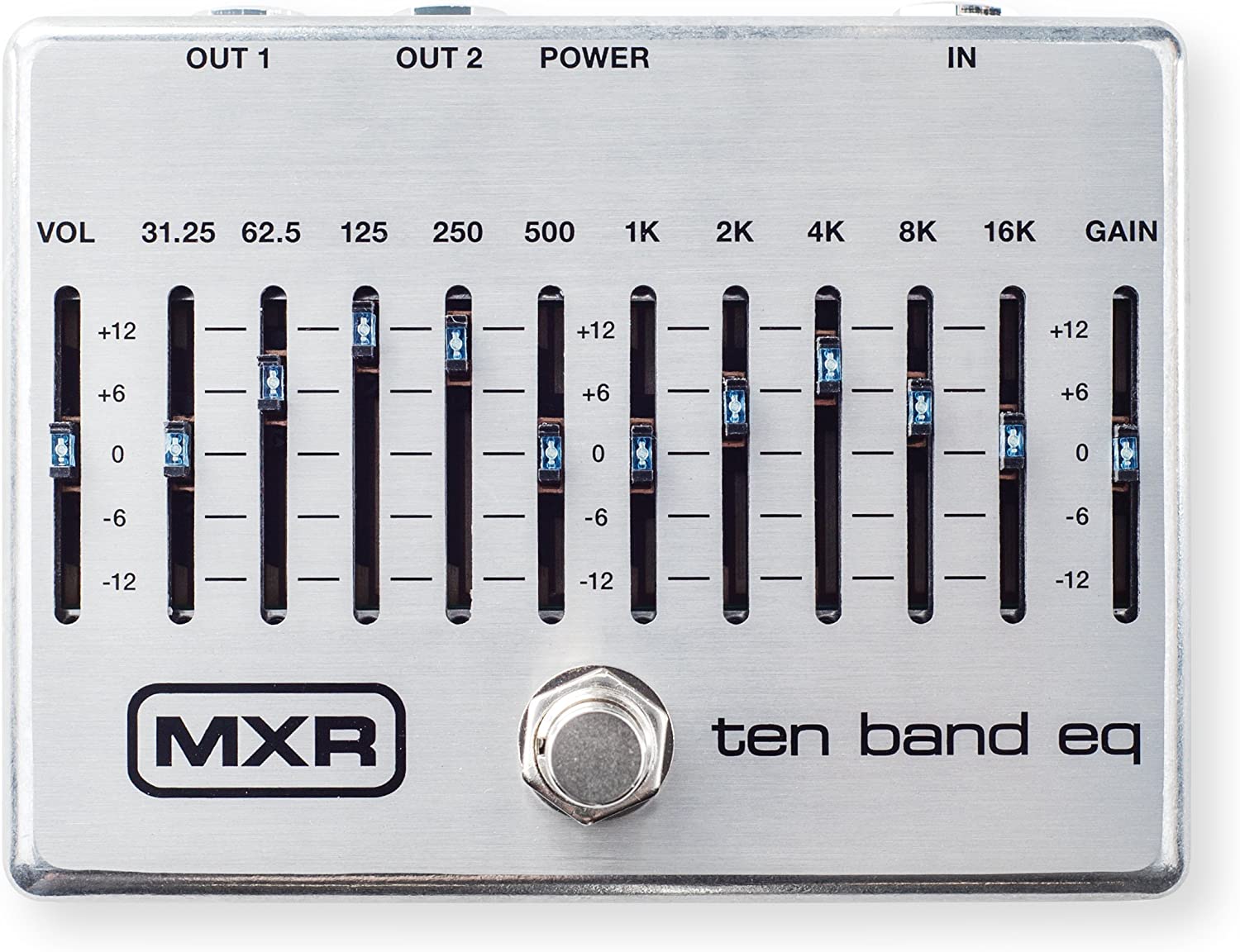
Made by the New York-based brand MXR, the Ten Band EQ Guitar Effects Pedal, model number M108S, is a versatile choice for guitarists looking to customize their sound.
Sporting a unique ten-band design allows you to adjust ten different frequency ranges, each up to plus or minus 12dB.
Thanks to this wide range, you’ll have plenty of scopes to craft your perfect guitar tone.
The MXR Ten Band EQ pedal stands out with its high-visibility LED lights, a feature that remains visible even under direct sunlight.
Powered by 18 volts, this pedal offers enhanced headroom for clearer, fuller sounds.
Adding to its practicality, the pedal features dual outputs, enabling you to run two distinct signal chains simultaneously.
Designed with convenience, this pedal is fitted with true bypass switching and comes encased in an aluminum shell that measures 9.25 x 4 x 2.5 inches and weighs just a pound.
Its compact, lightweight design is perfect for traveling musicians.
- My Review
When you first see the MXR Ten Band EQ Guitar Effects Pedal, you immediately notice its robust aluminum body that screams durability.
Not one to shy away from a busy gig schedule; it can take a fair bit of onstage action without so much of a scratch.
In addition, its compact size and feather-light weight of just a pound make it the ideal travel companion.
What sets this pedal apart is its impressive ten-band functionality.
You can tweak ten distinct frequency ranges to craft the perfect guitar tone, and you’ll have plenty of room for fine-tuning, thanks to the +/- 12dB range.
I found this feature a godsend for creating a rich, complex sound.
The high-visibility LED lights are a feature that you can’t ignore.
So bright as a lighthouse beacon, they’re visible even under the harsh stage lights, but be warned – these LEDs are not for the faint-hearted.
Stare at them for too long, and you might see spots!
It’s like trying to play guitar while staring directly into the sun.
The pedal’s 18-volt operation promises more headroom for a fuller, more vibrant sound.
However, a specific 18V power supply could be a hassle, especially for globetrotting guitarists with different voltages.
An interesting addition is the dual output feature.
With the ability to run two separate signal chains, you can explore a broader range of sonic possibilities.
Despite its merits, it’s not without its faults.
The uppermost frequencies can seem harsh, adding to the noise factor.
Here are the ratings I’ll give to the MXR Ten Band EQ Guitar Effects Pedal:
Furthermore, the pedal appears susceptible to interference, sometimes picking up unwanted signals.
Still, like a beautifully temperamental diva, the MXR Ten Band EQ Pedal, with its quirks, proves an enticing choice for any guitarist keen on fine-tuning their sound.
- Pros:
- Two outputs for running separate signal chains
- True bypass switching
- Excellent quality and durability
- Great for brightening up muddy tones
- Noiseless operation
- Cons:
- LEDs can be excessively bright
- Requires a specific 18V power supply
- No presets available
My final verdict is that the MXR Ten Band EQ Guitar Effects Pedal is a highly versatile and feature-rich pedal with excellent tone and performance.
The MXR brand is well-known for producing quality effects units.
While it offers great value in terms of its capabilities, the excessively bright LEDs and the requirement for a specific power supply are minor drawbacks.
It is recommended for guitarists seeking precise control over their tone.
MXR Six Band EQ Guitar Effects Pedal
MXR’s Six Band EQ for precise sound sculpting.
MXR Six Band EQ offers +/-18dB of cut or boost for precise control over sound, plus noise-reduction circuitry, true bypass switching, and bright LEDs. Perfect for creating scooped-mid tones, adding warmth, eliminating feedback, and boosting leads.
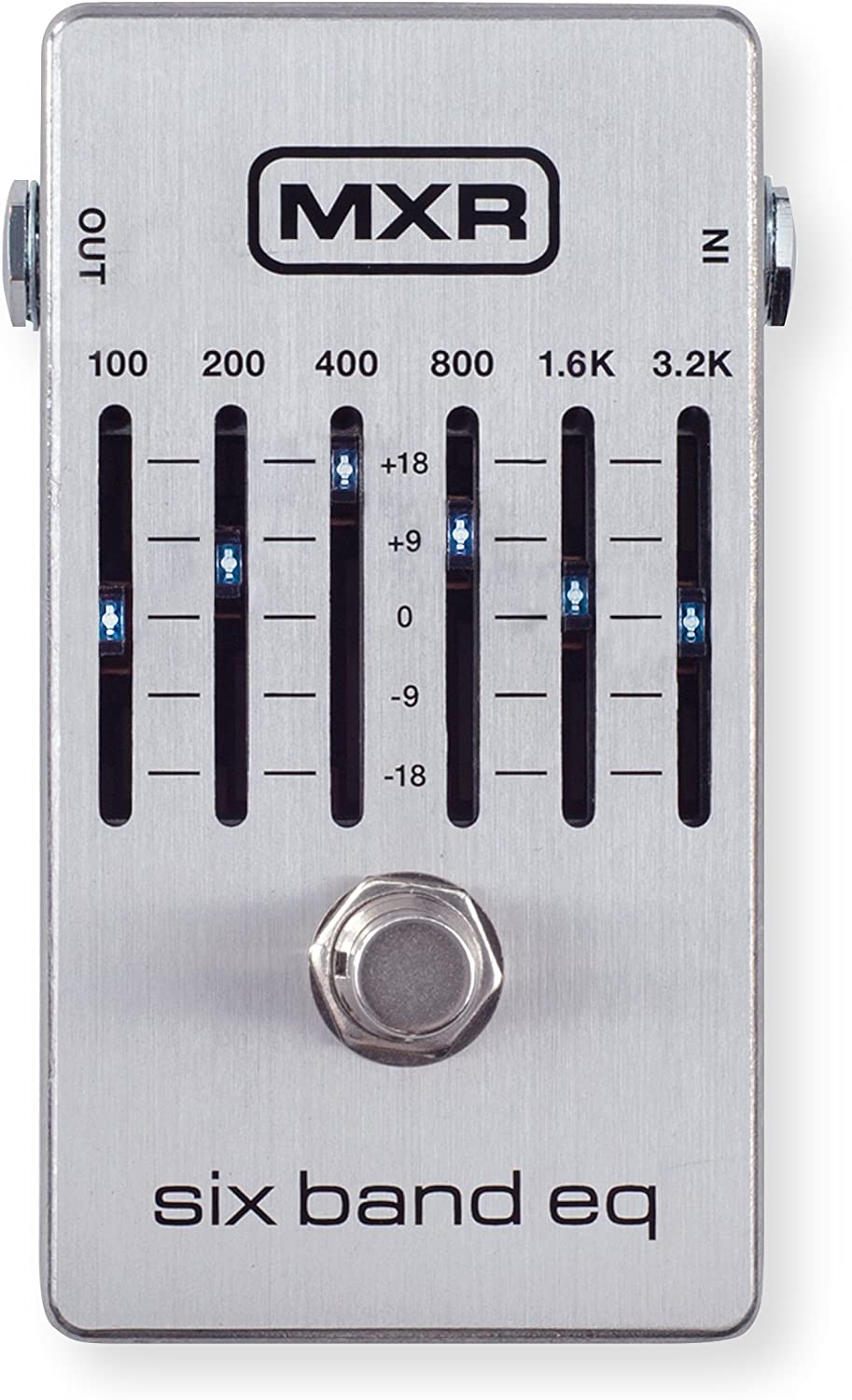
Let’s delve into the nitty-gritty of the MXR Six Band EQ Guitar Effects Pedal.
Hailing from Rochester, New York, MXR, a manufacturer revered for its robust effects pedals, brings you this unique guitar companion.
Intricately designed, this pedal lets you tweak six distinct frequencies, enhancing your sound output with precision and ease.
Plus, it offers high visibility even under direct sunlight, thanks to its radiant LED lights.
A model that boasts a low noise floor, it’s no surprise that musicians consider it a valuable addition to their equipment.
As a feature that ensures sound purity, the MXR Six Band EQ pedal incorporates true bypass switching, meaning your signal stays untainted when the pedal is off.
Additionally, its small footprint, coming in at 5.5 x 4.5 x 2.5 inches and weighing just over half a pound, is a practical choice for on-the-go musicians.
With 9 volts of power, this MXR model, identified as M109S, is set to make waves in your sound experience.
- My Review
After spending ample time exploring the features of the MXR Six Band EQ Guitar Effects Pedal, I can tell you it’s a sound investment for any sound enthusiast seeking to elevate their sonic journey.
With its ability to let me amplify or attenuate six distinct frequencies, I could quickly see how this versatile piece of gear stood out.
In addition, I appreciated the clear and user-friendly layout, making dialing in just the right sound easy.
Outside on a sunny day? Not a problem at all.
Those radiant LED indicators remain visible, ensuring I never lose sight of my settings.
It was like a beacon in direct sunlight, guiding my sonic exploration.
One feature that pleasantly surprised me was the low-noise floor.
A feature not to be taken for granted, as it kept my sound clean and uncluttered.
Similarly, the true bypass switching was a win for maintaining the authenticity of my guitar tone.
Aesthetics aside, the practicality of this pedal, with its compact dimensions and lightweight design, can’t be understated.
You could easily toss it in your bag and hit the road without worrying about taking up too much space or adding excess weight.
If I had to nitpick, I’d have loved a master to gain control of this EQ.
Again, not a deal-breaker, but it would have given a bit more flexibility in shaping the overall sound.
No piece of gear is ever perfect.
With the MXR Six Band EQ pedal, you’re getting a reliable, easy-to-use, and effective tool for sound shaping.
I’ve been able to dial in a spectrum of tones, from warm and mellow to bright and sharp.
Here are the ratings I’ll give to the MXR Six Band EQ Guitar Effects Pedal:
It’s like having a sonic Swiss Army knife at your disposal.
So whether you’re a hobbyist or a pro, this pedal will serve you well.
- Pros:
- Accurate EQ control.
- No noticeable noise.
- Durable and well-made.
- High visibility LEDs.
- Useful for various music genres.
- Cons:
- No included power adapter.
- Lacks a master gain control.
- Potential tone degradation over time.
My final verdict is that the MXR Six Band EQ Guitar Effects Pedal is a highly capable and reliable product.
With its accurate EQ control, low noise floor, and durable construction, it offers excellent performance and enhances the overall tone of your guitar.
The MXR brand has a strong reputation in the industry, and the value provided by this pedal is commendable.
While it lacks a master gain control, and there have been occasional reports of potential tone degradation over time, these drawbacks are outweighed by its versatility, features, and overall performance.
Overall, I would recommend the MXR Six Band EQ Guitar Effects Pedal to guitarists looking to fine-tune their sound and achieve greater tonal control.
Orange Two Stroke Active Dual-Parametric EQ/Boost Pedal
Seamless control and increased headroom with dual-parametric EQ/Boost.
The Two Stroke Boost EQ offers 12dB of clean boost and a dual parametric EQ for fine-tuning sound and pushing an amp’s front end with unprecedented control. Its internal charge pump and buffered bypass ensure clean and quiet operation in any setup.
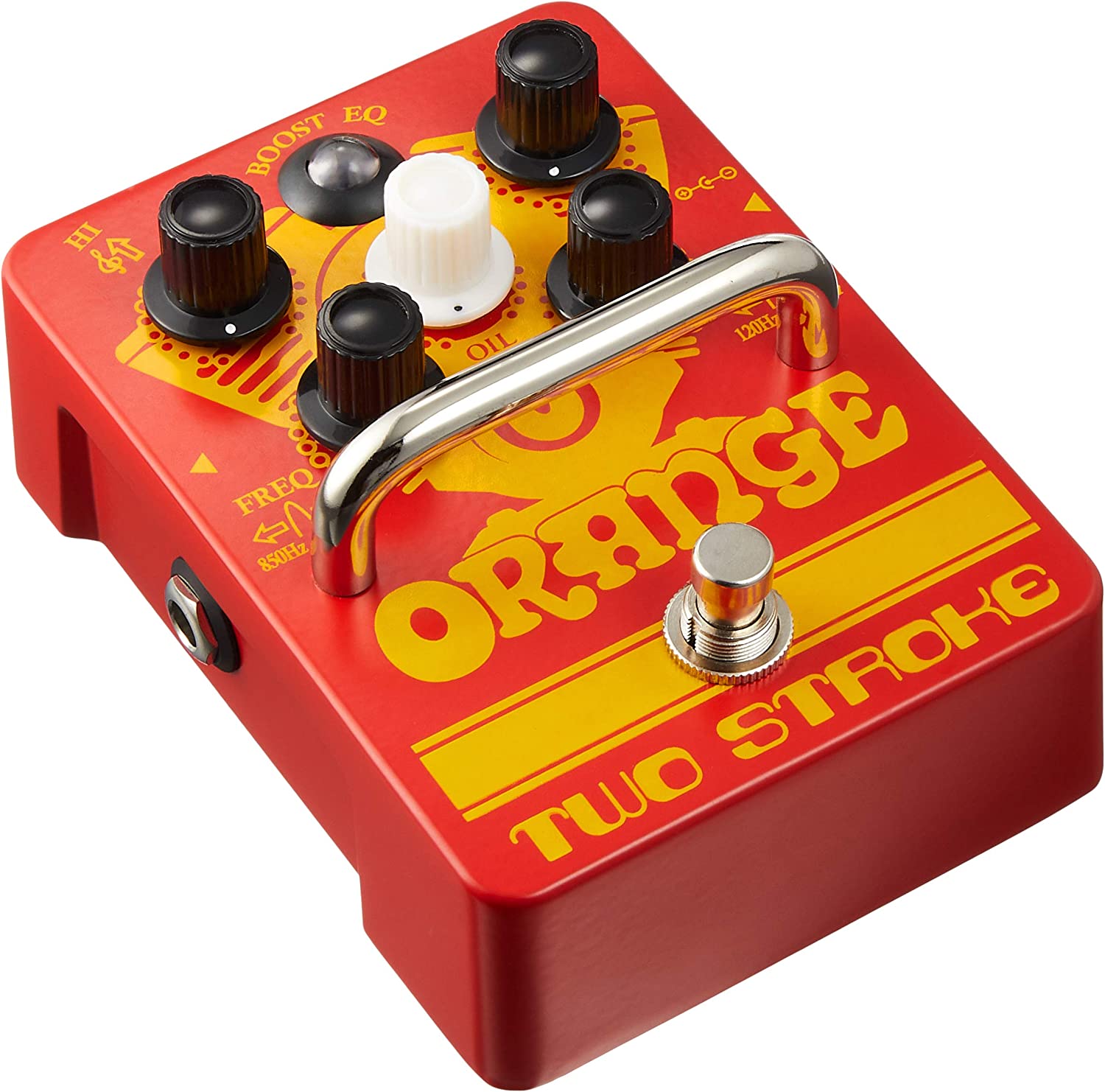
Let’s delve into the nitty-gritty of this guitar effects pedal, affectionately known as the Orange Two Stroke.
This little powerhouse is a dual-function device, operating as a clean boost and an active dual-parametric EQ, enabling meticulous control over your tone.
An impressive 12dB of clean boost provides ample power to drive your amp’s front end into overdrive.
But it doesn’t stop there.
This pedal possesses an active dual-parametric EQ, giving you complete control to shape your unique sound.
In addition, it’s designed with two independent parametric bands that allow you to adjust your high and low frequencies.
This innovative approach provides more flexibility than a traditional tone stack, offering a more natural and seamless tone control.
Hidden within its sturdy casing is an internal charge pump that elevates the operating voltage to 18V, reducing noise and boosting headroom.
And don’t worry about any compromise on your guitar’s tone; it sports a transparent buffered bypass, ensuring a maintained tonal integrity.
To cap it off, it comes with a reassuring 1-year warranty.
All this in one small, pedalboard-friendly package!
- My Review
While it may seem unassuming, the Orange Two Stroke guitar effects pedal is a pocket powerhouse.
Straight away, I appreciated its straightforward design and solid build.
Each knob feels smooth, inviting endless exploration of this pedal’s unique tonal landscapes.
Packed within its compact frame, it houses a clean boost and an active dual-parametric EQ.
Cranking up the 12dB boost is like turning your amp up to 11—it saturates the front end beautifully.
Even more impressive is the subtlety it allows; small adjustments add that extra dimension to solos without causing any tonal mayhem.
The dual-parametric EQ is an incredibly versatile tool in this tonal toolbox.
The ability to tweak both high and low frequencies independently puts the reins of your sound firmly in your hands.
And this isn’t just any EQ—its parametric nature allows a level of control that’sakin to conducting a symphony, fine-tuning every instrument until they all play in perfect harmony.
Under the hood, the internal charge pump doubles the operating voltage to 18V.
The result is a pedal that has more headroom than a skyscraper and exhibits a noticeably lower noise floor.
This refinement is like having a Swiss watchmaker fine-tune your pedal, ensuring every gear interlocks seamlessly with the next.
Although I loved the pedal’s sonic flexibility, I did notice that getting it set up just right requires some finesse.
Think of it as a temperamental artist: demanding, yes, but with a little patience and understanding, the results are worth it.
Lastly, the transparent buffered bypass is a thoughtful touch that maintains your guitar’s upper harmonic content, no matter how long your cable runs or how massive your pedalboard is.
Here are the ratings I’ll give to the Orange Two Stroke Active Dual-Parametric EQ/Boost Pedal:
In a sense, this pedal is like a faithful canine companion: It might take a little training and time to get used to each other, but once you do, it’s hard to imagine life without it.
And let’s be honest, who wouldn’t love a pedal that obeys your every command?
- Pros:
- 12dB clean boost.
- Active dual-parametric EQ.
- Transparent buffered bypass.
- Internal charge pump for increased headroom.
- Versatile tone shaping capabilities.
- Cons:
- Possible noise/hiss at higher settings.
- Footswitch issue reported by one user.
- Non-English critical review regarding accessories.
My final verdict is that the Orange Two Stroke Active Dual-Parametric EQ/Boost Guitar Effects Pedal is a highly versatile and feature-rich pedal that offers excellent tone and performance.
The positive reviews from users highlight its ability to enhance the sound of various amplifiers and its seamless control over tone shaping.
In addition, the brand reputation of Orange further adds to its appeal.
While there were a few reported issues, like possible noise at higher settings and a single user mentioning a footswitch problem, these appear to be isolated incidents.
Considering its features, performance, and value, the Orange Two Stroke EQ/Boost Pedal receives a positive verdict.
EX 7 Band EQ Equalizer Mini Guitar Pedal
Powerful analog circuitry in a mini pedal for versatile tonal control.
EQ 7-Band EQ Mini Equalizer Pedal offers 7-bands to cut or boost frequencies, perfect for tonal sculpting and boosting. It’s a great compact solution for guitarists looking to shape their tone and create their own sound. EX Pedalboard Bundle is great for beginners and advanced guitarists alike, providing affordable yet quality gear to make great music.
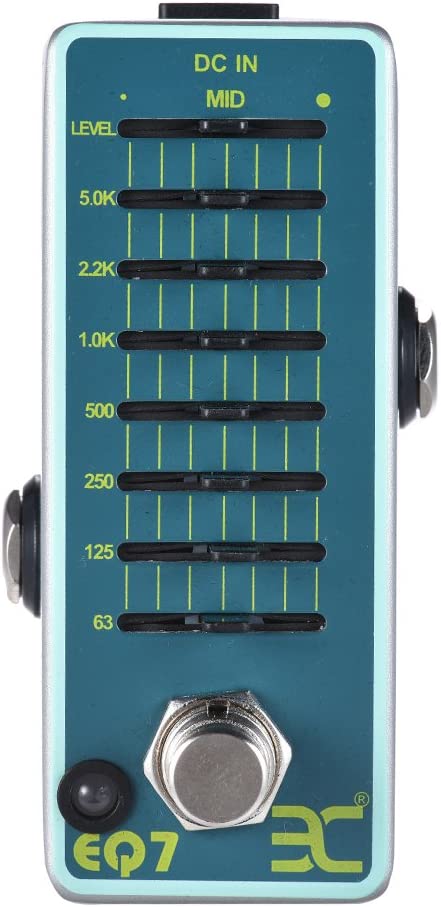
This compact device, the EX 7 Band EQ Equalizer Mini Guitar Pedal, is a remarkable tool for musicians aiming for precise tonal control.
Equipped with a seven-band EQ, it offers a substantial +/- 15 db range within a small form factor, making it a practical addition to any musician’s setup.
Individual sliders offer precise control over 65, 125, 250, 500, 1k, 2.2k, and 5k frequencies, allowing users to shape their tone effectively.
Additionally, the unit has overall gain control and boasts quiet true bypass electronic switching.
A bright LED feature enhances visibility and ease of use during performances or recording sessions.
This unit shows its true power with its robust analog circuitry in a compact die-cast box.
It accommodates 1/4 inch input and output jacks and an AC adapter input, operating on a standard 9-volt negative tip power supply.
However, it’s important to note the adapter isn’t included with the product.
The device’s small footprint doesn’t compromise on sound, making it an ideal choice for musicians at any level.
- My Review
Strumming the first chord with the EX 7 Band EQ Equalizer Mini Guitar Pedal plugged in, it was clear that this small device punched above its weight.
This was no David and Goliath tale but more akin to a wizard wielding a wand of compact power.
It sculpted the tone into something crisp and unique, just as an artist would chisel their vision from a block of marble.
What immediately grabbed my attention was the level of control it offered.
Each slider served as a gateway to a range of frequencies; moving them up and down felt like stirring different ingredients into a sonic recipe.
The versatility was truly impressive, a pinch of this, a dash of that.
When it came to noise, it was like standing in a library, hardly a murmur.
The true bypass electronic switching worked flawlessly, ensuring the raw, untouched signal passed without unwanted noise or interference.
Moreover, the bright LED was like a beacon in the dark, lighting the way during late-night gigs and sessions.
Despite its many attributes, the unit wasn’t without its drawbacks.
One slight inconvenience was the absence of an included power adapter.
I found this a little peculiar for a device of this nature, as it’s essential for operation.
Build-wise, this tiny titan didn’t disappoint.
Encased in a sturdy, die-cast box, it was built to withstand the bumps and bruises of life on the road.
Even with my heavy foot, the gadget held up well and continued to serve faithfully, never faltering or losing its sheen.
Here are the ratings I’ll give to the EX 7 Band EQ Equalizer Mini Guitar Pedal:
Ultimately, the EX 7 Band EQ Equalizer Mini Guitar Pedal proved a faithful companion for any tone quest.
Of course, it wasn’t without a few quirks, but it showed that sometimes, big things come in small packages.
- Pros:
- Compact size for pedalboard
- Accurate tone shaping with 7 bands
- Flexible and easy to use
- Versatile for live settings and soloing
- True-bypass with powerful analog circuitry
- Cons:
- Slider labels are hard to read
- Small knobs not suitable for foot control
- Switch may produce noticeable sound
My final verdict is that the EX 7 Band EQ Equalizer Mini Guitar Pedal is a solid choice for guitarists seeking a compact and versatile EQ pedal.
It’s accurate tone-shaping capabilities and flexible usage offer a range of adjustment options for different musical circumstances.
While minor drawbacks include the readability of slider labels and the potential for a noticeable switch sound, this pedal’s overall performance and value make it a worthwhile addition to any pedalboard.
Caline 10 Band EQ Guitar Pedal
Caline CP-24 10 Band EQ Pedal for enhanced sound control and boosted tone.
This prewired Telecaster guitar pickup set provides bright, responsive, and virtually noiseless sound with a hassle-free, solderless installation. The control plate comes pre-mounted with switch, volume, and tone pots, making it easy to upgrade Tele style guitars.
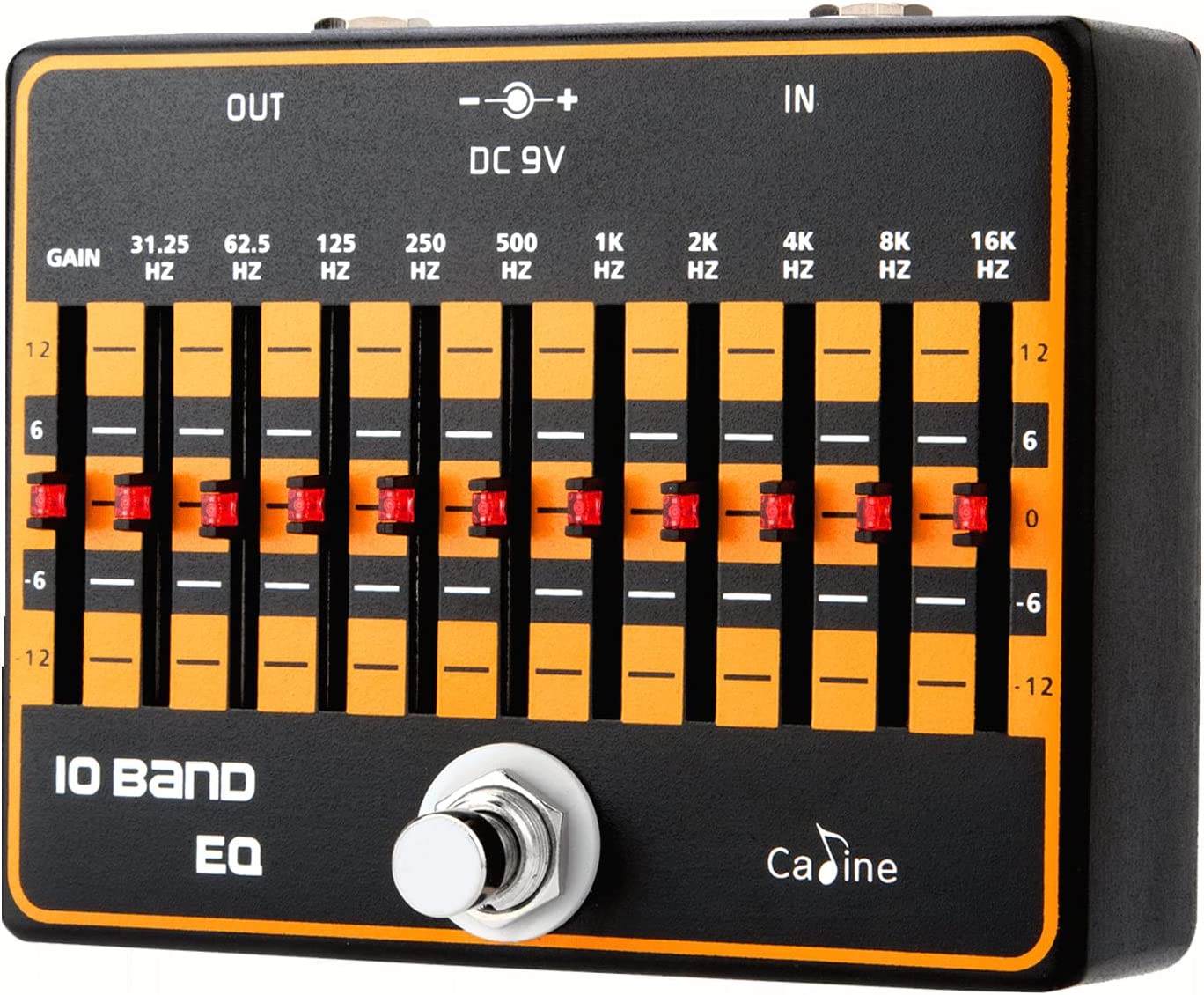
The Caline CP-24 Guitar EQ Pedal is a versatile equalizer that accommodates 4-string, 5-string bass, and 6-string to 7-string guitars.
Featuring a 10-band equalization, it includes fundamental frequencies ranging from 31.25Hz up to 16kHz, allowing for a wide selection of tonal adjustments.
This compact pedal comes with a convenient gain control knob, offering a +/- 12 dB boost for standout solos or driving tube amps into overdrive territory, while the LED light on each knob flickers as you adjust the settings.
The pedal operates on 9V DC power with a 30-milliamp current draw and has an aluminum-alloy housing for durability.
Finished with a classic stoving varnish, the strong structure assures the pedal’s stability.
Its portable and lightweight design, measuring just 120-95-35cm and weighing 300g, makes it a handy addition to any guitarist’s collection.
Offering extensive tone shaping and level control across ten different guitar-specific frequencies, the Caline CP-24 EQ pedal delivers impressive performance.
- My Review
Having tried the Caline CP-24 Guitar EQ Pedal, I must say it provides versatile tonal options for musicians.
Sporting a 10-band equalizer catering to a wide range of fundamental frequencies, it suits different guitars, from 4-string and 5-string basses to 6-string and even 7-string guitars.
Moreover, with this comprehensive range, it lives up to its promise by offering flexible tone-shaping possibilities.
As soon as I plugged it in, I appreciated the responsive gain control knob.
A nifty feature of the device, it allowed me to boost solos easily or push my tube amp into delicious overdrive territory — a guitarist’s dream, if you will.
In addition, the blinking LEDs on each knob helped me visualize the changes.
These details made the pedal feel both user-friendly and reliable.
However, while examining the build, I noticed that the casing seemed less sturdy than I had envisioned.
Yet, despite this initial impression, I trust that its aluminum-alloy construction and stoving varnish finish can withstand a fair bit of wear and tear.
One thing that stood out to me is the travel-friendly design of the pedal — its compact size (1209535cm) and lightweight nature (only 300g!) made me feel confident that it would be easy to take on the road for gigs or jam sessions.
The only minor issue I faced with the pedal was a slight buzz at low volumes; however, it is important to note that it didn’t significantly impact my overall playing experience.
Here are the ratings I’ll give to the Caline 10 Band EQ Guitar Pedal:
In short, the Caline CP-24 Guitar EQ Pedal is a solid tool for musicians seeking to enhance their guitar’s tone.
Its features offer wonderful tone shaping and level control across various guitar frequencies, ensuring satisfying tonal results for players of all skill levels.
- Pros:
- Versatile 10-band equalizer.
- Responsive gain control knob.
- Compact and lightweight design.
- Cons:
- Potentially less sturdy casing.
- Slight buzz at low volumes.
My final verdict is that the Caline CP-24 Guitar EQ Pedal is an excellent choice for musicians looking to enhance their guitar tone with versatile tonal options, user-friendly features, and great value for money.
Jackson Audio Prism EQ and Boost Guitar Effects Pedal
Jackson Audio Prism EQ & Boost: Ultimate tone-shaping tool with +/-15dB EQ, 3 boosts, & buffer.
Jackson Audio Prism combines buffer, boost, preamp, EQ and overdrive for ultimate tone sculpting. It features a +/-15dB active EQ for customized sound, 3 discrete boost/preamp circuits, a high current buffer, and a stainless steel enclosure with laser engraved artwork.
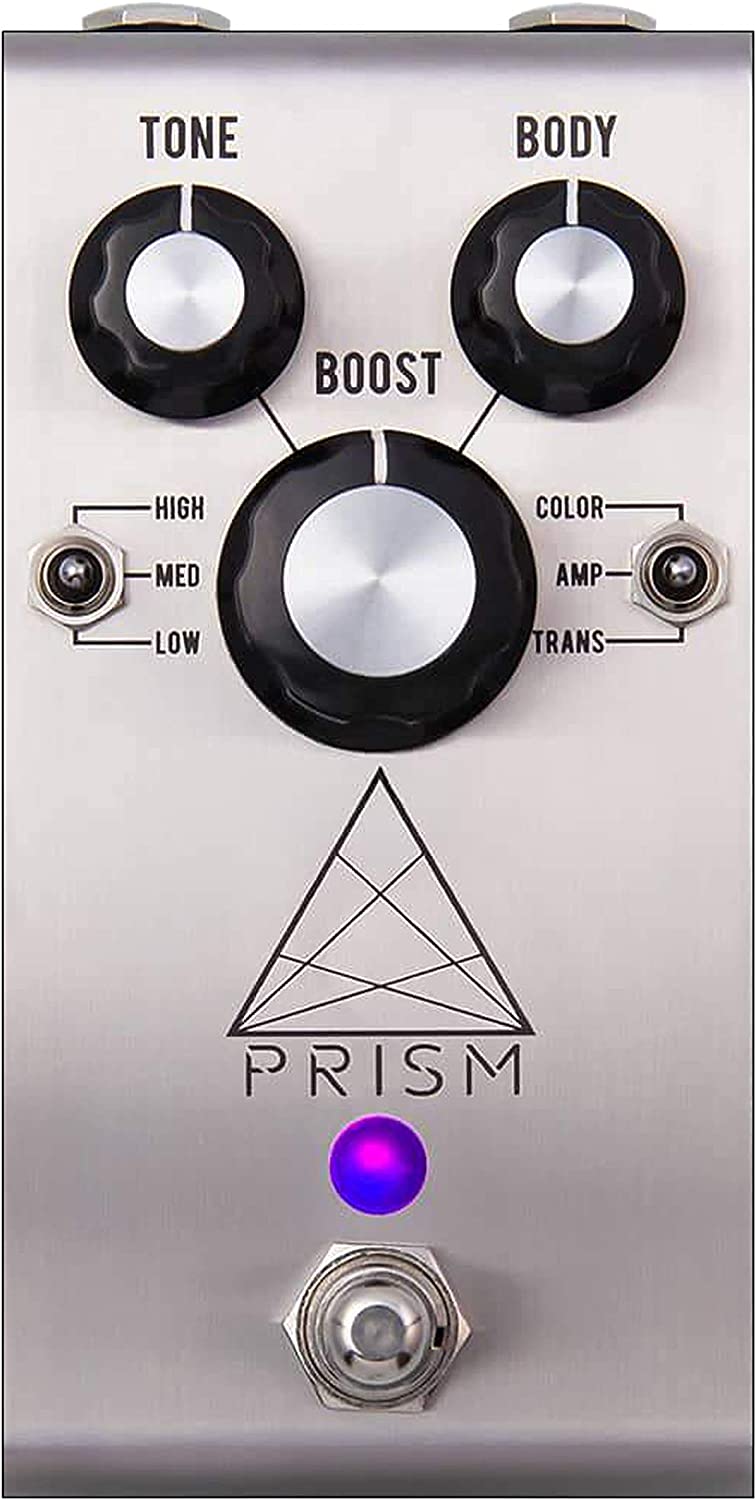
The Jackson Audio Prism EQ and Boost Guitar Effects Pedal in stainless steel is a versatile and powerful addition to any guitarist’s pedalboard.
This compact pedal is designed to shape and enhance your guitar’s natural tone, allowing you to boost, shape, and transform your sound into something unique.
The Prism boasts multiple features like an active Tone control for high-frequency adjustments, Body control for low frequencies, and a Boost control acting as a master volume.
In addition, it has a Pre Gain switch for selecting gain levels for each boost circuit, and a Circuit Select enables you to choose between three different boost circuits such as COLOR, AMP, and TRANS.
With its buffer, boost, preamp, EQ, and overdrive functions all housed in one stylish stainless steel enclosure, it makes for an essential and efficient part of any guitarist’s setup.
In addition, the Jackson Audio Prism is designed to work with your existing pedals and slam the front of your amp, ensuring it remains a crucial component in your guitar rig for years to come.
- My Review
Upon trying out the Jackson Audio Prism EQ and Boost Guitar Effects Pedal, I found it incredibly versatile and powerful for any guitar player seeking to fine-tune their tone.
This stainless steel gem proved to be an asset on my pedalboard, helping me craft my unique sound while feeling right at home with my existing setup.
The active Tone and Body controls offered me precise adjustments in high and low frequencies without any interference between them.
It felt almost like having my audio paintbrush, allowing me to add subtle nuances or make broad strokes in shaping my overall sound.
In addition, the Boost control allowed me to fine-tune the relation between gain and volume, making it a seamless sonic transition from clean to overdriven tones.
Switching between the three distinct boost circuits, I was impressed by the versatility of the COLOR, AMP, and TRANS options.
The COLOR circuit brought me back to the vintage vibes of Brian May’s tone, while the AMP circuit added a pleasantly warm and dynamic response.
The TRANS circuit’s ultra-transparent JFET boost was like a sonic magnifying glass, amplifying my playing without altering its character.
While the Jackson Audio Prism undoubtedly met most of my expectations, I wish it had a dedicated volume control for added flexibility.
Otherwise, this pedal proved musically inspiring and visually appealing in its stainless steel enclosure.
Trying out this pedal felt like unlocking a treasure chest of tonal possibilities.
However, the price tag did give me a moment of pause.
Here are the ratings I’ll give to the Jackson Audio Prism EQ and Boost Guitar Effects Pedal:
Despite that, the substantial tone-shaping potential and the level of customization it provides make this pedal worth every penny, especially for players looking to tailor and unify the sound of different guitars and amps.
And as they say, you can’t put a price on your sonic fingerprint.
- Pros:
- Highly versatile boost options.
- Precision EQ and gain control.
- Stylish stainless steel enclosure.
- Cons:
- Lacks dedicated volume control.
- Premium price point.
My final verdict is that the Jackson Audio Prism EQ and Boost Guitar Effects Pedal is an essential investment for guitarists seeking a versatile and powerful tone-shaping tool.
Its exceptional performance and range of features make it a valuable addition to any pedalboard.
VSN 5-Band Guitar EQ Pedal
Active EQ, gain control, and 26dB boost for a powerful tonal palette.
SPARK BOOSTER provides powerful boost with gain control and active EQ for precise tonal shaping, allowing you to cut through any mix with 26dB of boost and mid-shift toggle. Gain knob adds extra grit and dirt for expanded tonal palette.
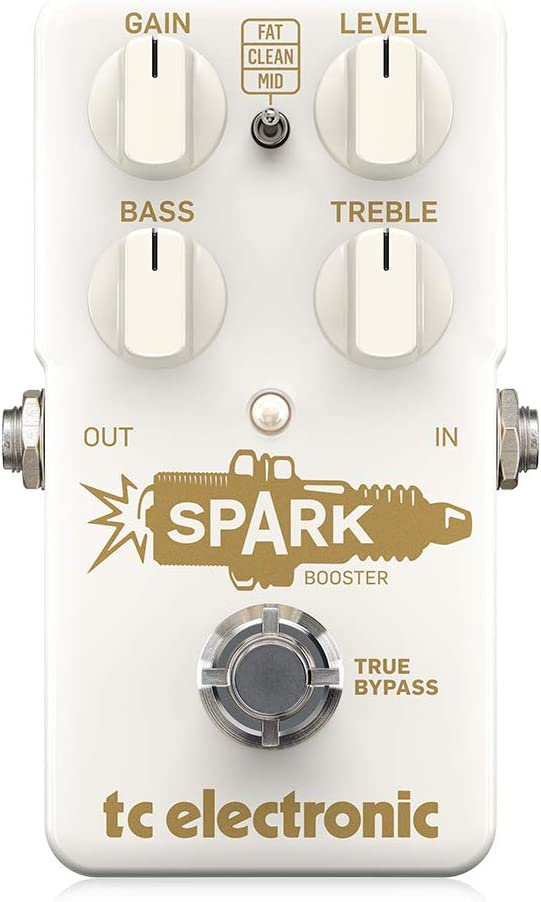
The TC Electronic Spark Booster is a fantastic pedal designed to enhance your guitar’s sound and give it the extra boost it needs for any situation.
This versatile pedal is perfect for clean boosting or adding a snarling punch to your tone, making it an essential addition to any guitarist’s setup.
In addition, the Spark Booster has a gain control and active EQ for greater precision and customization.
With dimensions of 4.72 x 2.56 x 2.95 inches and weighing 0.29 kilograms, this pedal is compact and lightweight, perfect for easy transport.
It operates at a voltage of 9.
In addition, the Spark Booster pedal provides up to 26 dB of boost, allowing you to kick your playing into high gear.
The pedal features a powerful gain knob that offers everything from subtle grit to heaps of dirt.
Its active 2-band EQ is a comprehensive set of tone-shaping tools, enabling you to tailor your guitar’s sound precisely.
Moreover, the mid-shift toggle lets you focus on and amplify mid-heavy frequencies, ensuring your guitar sounds great and cuts through any mix.
- My Review
Throughout my experience with the TC Electronic Spark Booster, it’s a truly versatile and impressive pedal.
Upon first plugging in my guitar and getting hands-on with the device, I noticed its compact and lightweight design made it convenient and easy to fit into my pedalboard.
What caught my attention the most was the flexibility the Spark Booster offered.
The gain control enabled me to dial in just the right amount of grit or dirt I wanted, providing a vast tonal palette to choose from.
In addition, the active 2-band EQ and the mid-shift toggle switch allowed precise shaping of the guitar’s sound, ensuring that every note cut through any mix elegantly.
Playing with this pedal felt like giving my guitar a shot of adrenaline.
A whopping 26 dB of boost helped add life to every riff, exaggerating the dynamics and allowing my solos to shine through.
It was like turning my tone to eleven without losing its character, evoking a phoenix rising from the flames.
However, no product is flawless.
Upon usage, I observed that the Spark Booster might slightly tweak the original treble characteristics of your amplifier.
While it didn’t dampen my excitement for the pedal, it is essential to consider this when planning your pedalboard setup.
The TC Electronic Spark Booster proved a powerful ally in my quest for the perfect tone.
Here are the ratings I’ll give to the VSN 5-Band Guitar EQ Pedal:
It harmonized particularly well with other pedals, and its sturdiness made me confident of its longevity.
The Spark Booster is an invaluable companion for guitarists searching for a reliable, adaptable pedal without breaking the bank.
- Pros:
- Versatile and adaptable.
- Powerful 26 dB boost.
- Active 2-band EQ controls.
- Cons:
- May alter amp’s treble slightly.
- Knobs can be moved accidentally.
- Skin subjective color scheme.
My final verdict is that the TC Electronic Spark Booster is a versatile and powerful pedal that delivers when it comes to features, tone, and value.
Despite minor drawbacks, it’s an excellent addition to any guitarist’s setup.
JOYO JF-11 6-Band EQ Pedal
A 6-band EQ pedal for versatile guitar tone shaping.
The JOYO 6 Band EQ pedal offers a customizable guitar tone with ±18dB adjustments across six frequency bands. This underappreciated tool enhances articulation, helps stand out in the mix, and reduces muddiness. Its true bypass and aluminium-alloy housing ensure quality and durability. JOYO boasts a decade-long reputation for budget-friendly, reliable music equipment.
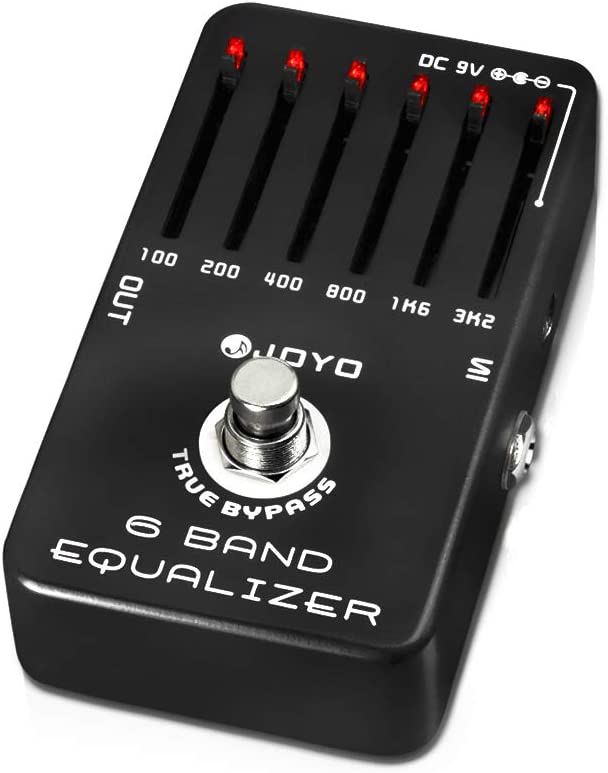
The JOYO 6-Band EQ Pedal is essential for electric guitarists seeking to fine-tune their sound.
This powerful gadget is designed to give musicians control over their tone by offering a range of ±18dB for each of its six frequency bands: 100Hz, 200Hz, 400Hz, 800Hz, 1.6kHz, and 3.2kHz. As a result, you can boost the highs to achieve clarity in overdrive, emphasize the mids to stand out in the mix or adjust the lows to lessen any muddy effects.
Featuring true bypass technology, this pedal maintains your guitar’s natural tone while storing its sturdy aluminum-alloy housing away when you’re finished playing your guitars.
JOYO has built its reputation around affordable gear, and its decade of experience extends to budget-friendly pedals, amps, wireless systems, controllers, metronomes, tuners, and more.
Please ensure your guitar is properly connected to the pedal for optimal performance.
AA JOYO original power adapter or compatible alternative that meets the current working standards of single pedals is strongly suggested to avoid unexpected noise and power issues to avoid unexpected noise and power issues.
- My Review
I recently tried the JOYO 6-Band EQ Pedal, and to my delight, it has proven to be an incredibly versatile and handy tool for shaping guitar tones.
By providing a range of ±18dB for six frequency bands, I had complete control over the sound and could easily carve out the perfect tone—no more muddy lows or highs drowning in distortion.
What caught my attention with this EQ pedal is the true bypass feature that maintains the natural integrity of my guitar’s tone.
In addition, I was thoroughly impressed with the build quality; the aluminum-alloy housing felt durable and well-crafted.
A not-so-jolly red giant’s painstaking work, disguised under the hood of this smaller-than-life pedal, speaks volumes of its strength.
While testing, I discovered that using the JF-11 EQ pedal enhanced clean tones the most.
While there was some impact upon applying overdrive, distortion, or fuzz, it was less significant; nonetheless, this pedal allowed me to hone in on the exact tone that fit each specific scenario.
One minor point of concern popped up when I realized there’s no master volume control.
This inconvenience requires some compensation when planning the pedalboard setup, requiring certain remedial steps like using a preamp or boost pedal.
In saying that, it’s hard not to recommend the JOYO 6-Band EQ Pedal at its current price range.
Here are the ratings I’ll give to the JOYO 6-Band EQ Pedal:
While slightly cumbersome, it packs a punch for a modest investment – granting budding guitarists access to higher quality without breaking the bank.
My suggestion for anyone keen on fine-tuning their sound: Spend a few more minutes adjusting settings, and let the JOYO EQ Pedal work its magic to sweeten your tone.
- Pros:
- Wide tonal control with ±18dB range.
- True bypass retains original guitar tone.
- Sturdy and reliable aluminum-alloy construction.
- Cons:
- Lacks master volume control.
- EQ impact less significant with overdrive.
- Battery compartment is tight.
My final verdict is that the JOYO 6-Band EQ Pedal is a fantastic option for those looking to refine and expand their tone without spending a fortune.
Its impressive versatility, durable build, and reasonable pricing make it a worthwhile addition to any guitarist’s collection.
Dunlop EQ Effects Pedal
Legendary sound, optimized for bass frequencies with Dunlop EQ Effects Pedal.
Dunlop Manufacturing has been creating world-class gear for musicians for 50 years, offering picks to pedals, accessories, and more. Their line of products is used and loved by renowned and current day stars. Dunlop’s innovations and classic sounds make them a leader in the music industry.
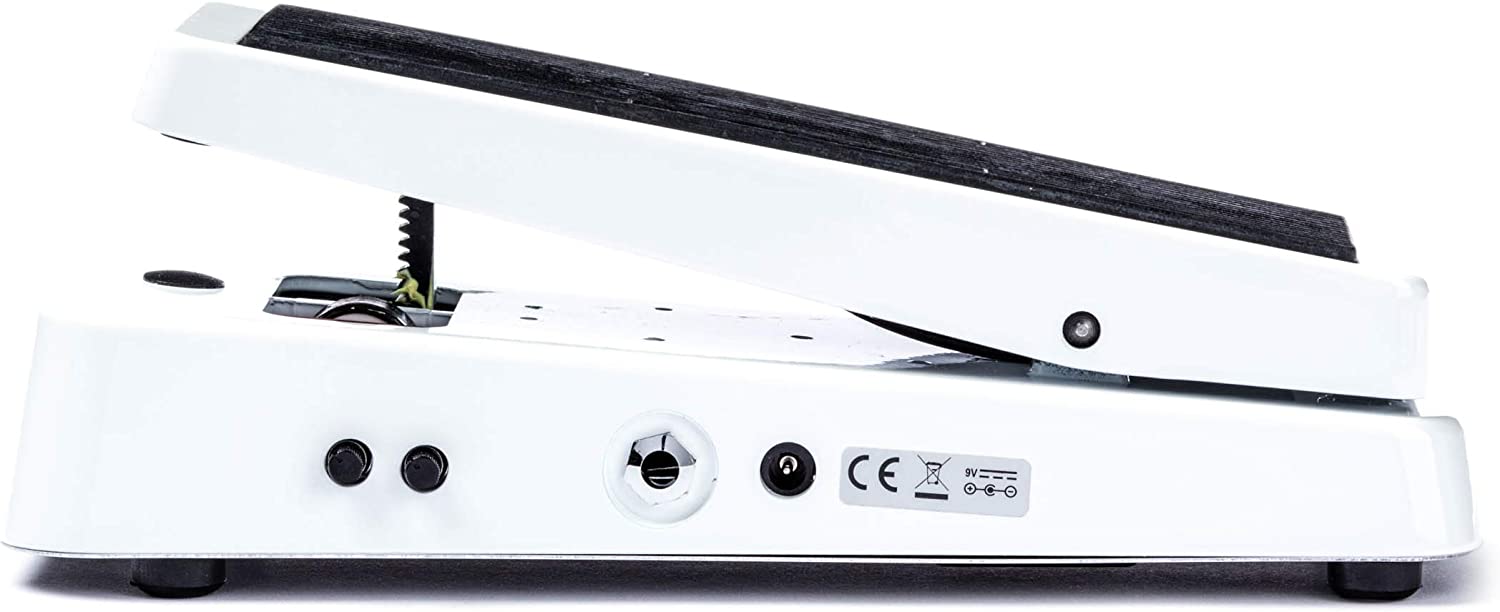
The Dunlop EQ Effects Pedal is specially designed for bass players.
Keeping bass frequencies in mind, its custom EQ circuitry and proprietary potentiometer are perfectly optimized for bass players.
Some great features of this pedal include separate Q and Volume controls and an auto-off switch.
The model number for this product is 105Q.
Crafted by the renowned brand JIM DUNLOP, this wah bass pedal comes in a stylish white color.
Its dimensions are 11 x 4.9 x 3.5 inches, and its weight is 3.8 pounds.
Many famous bassists, such as Flea, Justin Meldal-Johnsen, Doug Wimbish, and Robert Trujillo, use this impressive pedal.
This pedal stands out due to its focus on being effective for all strings on the bass guitar, making it a versatile and reliable option for bassists of all skill levels.
In addition, Dunlop Manufacturing has consistently produced top-notch accessories for musicians for 50 years, so you know you are getting a product designed with a deep understanding of musicians’ needs.
- My Review
Being an ideal wah pedal for bassists, the Dunlop EQ Effects Pedal impressed me.
I must say, this little gadget truly lived up to its reputation.
The pedal comes in a stylish white design, and its robust build ensures it can easily withstand the rigors of a musician’s life.
In my experience, this pedal was born to be on the stage.
While experimenting with different setup configurations, one of the features that caught my attention was the separate Q and Volume controls.
These controls certainly offered a remarkable degree of precision, allowing me to find that perfect balance between warm lower mids and detailed screeching highs.
It’s like having the key to a treasure chest of tones at my feet.
The unique auto-off switch function was a breath of fresh air in the world of wah pedals, as I no longer needed to tap the toe like in other models.
This paved the way for a smooth, quick, and effortless transition between using the wah effect and not having it engaged.
A significant advantage that sets this pedal apart is its dedicated design for bass guitars.
It comfortably and effectively applies the wah sound across all strings, regardless of tuning.
It’s like searching for gold and discovering that your metal detector was specifically built for that purpose.
Powering it up took some extra planning, as you have to use a 9-volt battery or compatible power supply.
None of these come included, but that’s a minor detail when it’s such a fantastic tool.
Here are the ratings I’ll give to the Dunlop EQ Effects Pedal:
The Dunlop EQ Effects Pedal is, without a doubt, a game-changer for bassists eager to unleash their creativity.
It’s like finding the road map to a sonic adventure many bass players may have been seeking their whole lives.
- Pros:
- Optimized for bass frequencies.
- Robust and stylish design.
- Separate Q and Volume controls.
- Cons:
- Requires external power source.
- Limited low-end wah response.
- Potential short delay on activation.
My final verdict is that the Dunlop EQ Effects Pedal stands out as a top-quality tool for bass players, offering high versatility, excellent features, and solid performance.
It’s tone quality and brand reputation make it a valuable addition to any musician’s collection.
SONICAKE Equalizer Guitar Effects Pedal
Tone up with SONICAKE’s 10-band EQ pedal for versatile sound.
Tone Group is a professional 10-band graphic equalizer pedal with analog circuit design. It offers ±15dB range parameter adjustments for each frequency band, perfect for fine-tuning your instrument’s tone. Its true bypass circuit ensures the original sound of your instrument and is suitable for a variety of instruments.
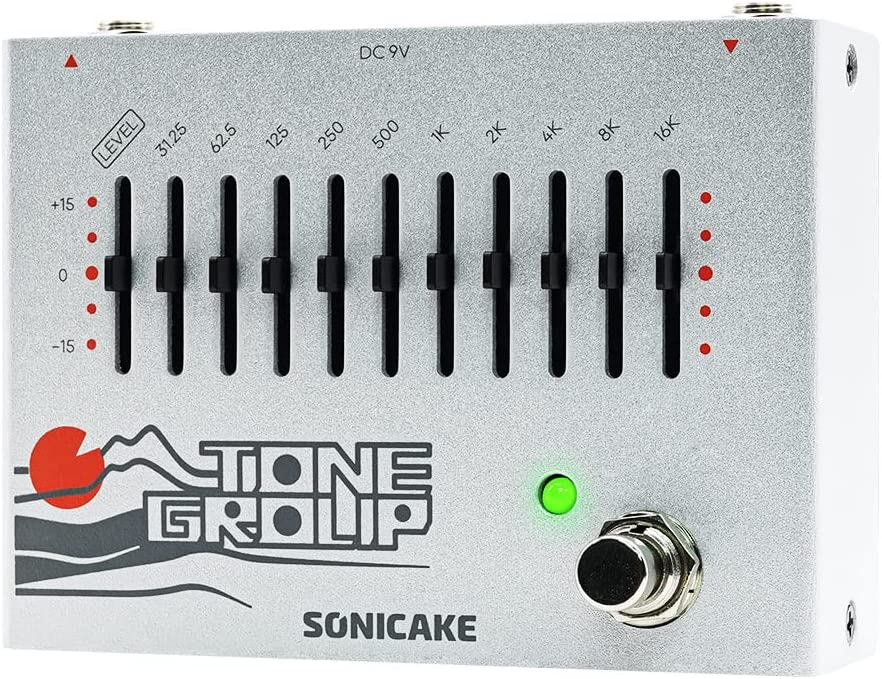
The SONICAKE EQ Equalizer Guitar Effects Pedal Tone Group 10-Band is an all-analog device designed to help guitarists precisely shape their sound.
It’s based on classic EQ pedals’ frequency bands, accommodating various instruments with its ±15dB adjustable gain range for each band.
Featuring 11 sliders, this guitar pedal allows users to adjust their tone quickly and accurately.
Its true bypass circuit ensures a clean signal path so your tone remains unaffected when the pedal is disengaged.
The pedal operates on a 9V center-negative power supply, which is not included in the purchase.
Constructed with a durable metal exterior, this equalizer is designed to withstand the rigors of use by musicians on the go.
Its dimensions measure 4.88 x 3.54 x 2.16 inches, making it suitable for a pedalboard setup.
Originally produced by SONICAKE, this equalizer comes in a classic-style design and EQ Equalizer color.
- My Review
Having tried the SONICAKE EQ Equalizer Guitar Effects Pedal Tone Group 10-Band, I must say that it’s an absolute game-changer in tonal versatility.
Crafted with an all-analog design, this invaluable accessory allows me to adjust my sound swiftly and seamlessly to suit any musical context.
Its ten bands’ remarkable variety of frequencies immediately caught my attention.
In addition, each band came with a broad ±15dB adjustable gain range that enabled me to tailor my tone with surgical precision, whether I was playing my guitar or another instrument.
While flipping through my musical repertoire, I appreciated the pedal’s true bypass circuit, which preserved my original tone whenever I disengaged the effect.
In addition, although a 9V center-negative power supply is necessary to keep the pedal functional, the fact that it’s not included didn’t pose a massive inconvenience to me.
A minor gripe I have is that it could be challenging to discern the exact settings of the sliders due to their minimal markings.
While this didn’t obstruct my experience in any significant way, having clearer indicators could benefit musicians striving for highly specific sound modifications.
The pedal’s sturdy metal construction left me confident that it could endure intense usage, living up to the demands of my passion.
Its dimensions also allowed for effortless integration into my pedalboard layout.
When it comes to guitar effects pedals, the SONICAKE EQ Equalizer stands out as a versatile and dependable option for both beginner and experienced musicians.
Here are the ratings I’ll give to the SONICAKE Equalizer Guitar Effects Pedal:
While the slider markings could use some improvement, the overall performance of this pedal is impressive and won’t break the bank.
It’s a valuable addition to any pedalboard and can help refine your sound to perfection.
- Pros:
- Wide frequency coverage.
- True bypass circuit.
- Durable, metal construction.
- Cons:
- Power supply not included.
- Unclear slider markings.
- Consumes considerable pedalboard space.
My final verdict is that the SONICAKE EQ Equalizer Guitar Effects Pedal Tone Group 10-Band delivers great versatility, solid performance, and immense value for musicians looking to enhance their sound.
Although it has minor design flaws, it is a fantastic addition to any pedalboard.
Digitech EQ Effects Pedal
Advanced pitch shifting with optimized bass frequencies, true bypass, and MIDI control.
The Bass Whammy is a modern pitch shifting effect pedal, optimized for bass. It uses advanced pitch detection and polyphonic note tracking to create smooth pitch shift effects with two tracking modes: classic and chord. It is true bypass, MIDI controllable and requires a 9V DC power supply.
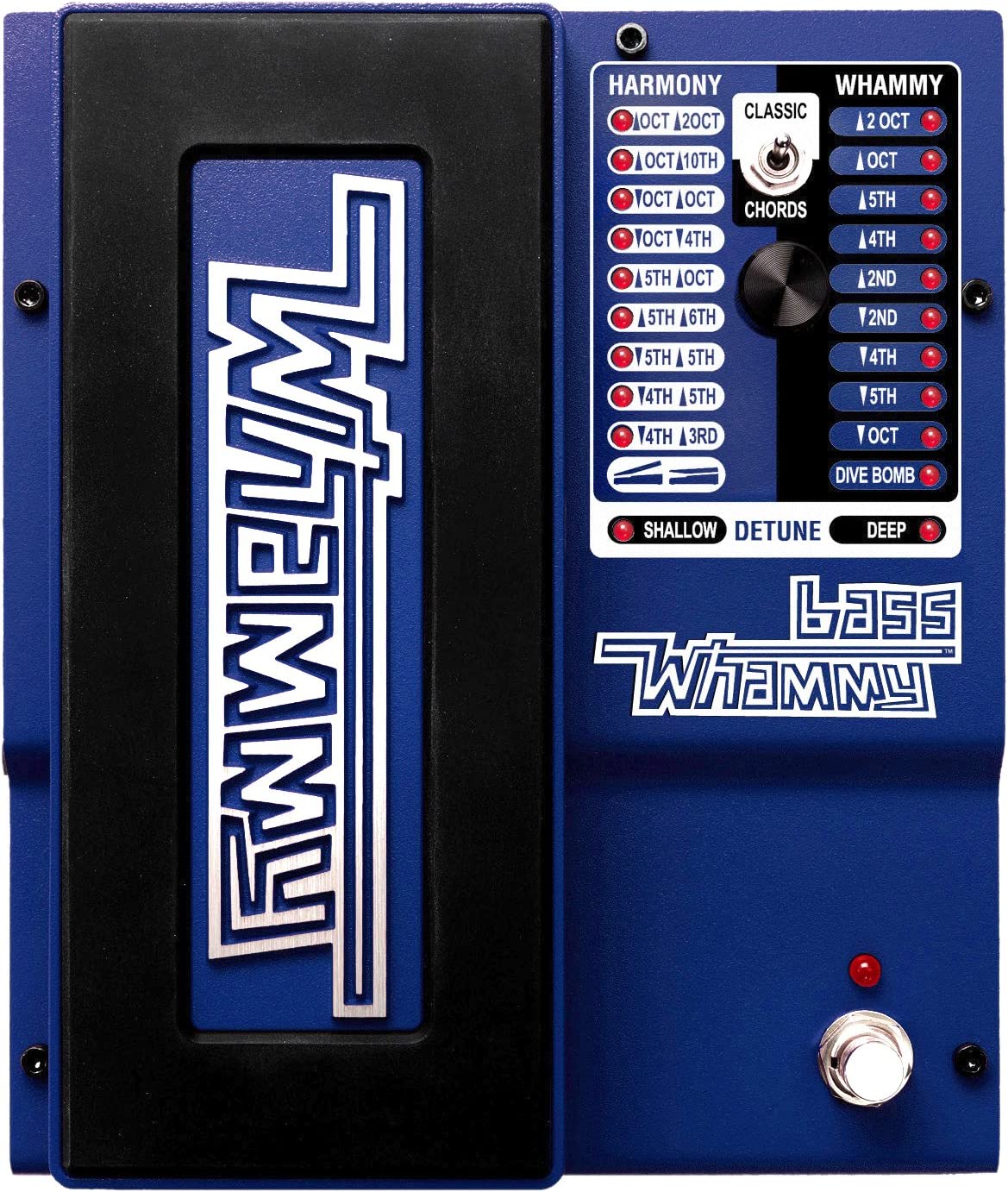
The Digitech EQ Effects Pedal, available in a regular blue color, is an advanced tool designed specifically for bassists.
This innovative pedal employs state-of-the-art pitch detection and polyphonic note-tracking technology, making it a top-tier pitch-shifting effect pedal.
The Bass Whammy retains the classic settings of the original model while incorporating contemporary upgrades that enhance its performance.
This pedal offers two distinct tracking modes – classic and chord.
The classic mode recreates the original shift glitch effects, while the chord mode uses advanced polyphonic tracking algorithms for a more precise and smooth pitch-shift effect.
Moreover, the Bass Whammy is a true bypass, controllable MIDI, and powered by a 9V DC adapter to integrate with any existing pedal board easily.
The Digitech EQ Effects Pedal has 21 different pitch settings, has a sturdy design, has item dimensions of 11 x 8.5 x 3 inches, and weighs 1.5 kilograms.
This pedal is a cutting-edge solution for bass players seeking to diversify their sound and explore new creative possibilities.
- My Review
Having personally experienced the Digitech EQ Effects Pedal in action, I must say it’s a game-changer for bass enthusiasts.
Right off the bat, its sleek blue finish and solid build piqued my interest, but it was the wealth of features that genuinely swept me off my feet.
As someone who appreciates creative flexibility, I found the two tracking modes – classic and chord – an invaluable combination.
Though classic mode occasionally produces digital artifacts with glitchy pitch shifts, it brings out a distinct character.
On the other hand, the chord mode feels seamless, akin to icing on a well-baked cake.
While I did notice a minor delay with the output signal in chord mode, it’s hardly an issue in most band scenarios.
When it comes to tone, I must admit the pedal has a somewhat cold and digital sound, especially with extreme pitch settings.
However, pairing it with an overdrive or distortion pedal effortlessly masks this characteristic, transforming the tone into a harmonious treat for the ears.
Another shining aspect of the Digitech pedal is its durability.
It has endured drops and everyday wear without issues, testifying to its road-worthy resilience.
That being said, treat the rotary switch carefully, as it might be prone to bending under rough use.
Navigating through the 21 different pitch settings, the vast potential for sonic exploration becomes evident.
In addition, the harmony modes and detune options add a new layer of depth to music-making sessions, adding texture to any composition.
Here are the ratings I’ll give to the Digitech EQ Effects Pedal:
Like a magician’s secret wand, the Digitech EQ Effects Pedal reveals extraordinary possibilities under a simple design.
Though it has some quirks, the positives far outweigh the cons, making it an indispensable tool to elevate any bassist’s creative game.
- Pros:
- Two tracking modes: Classic and Chord.
- Durable and road-ready construction.
- Vast pitch settings for sonic exploration.
- Cons:
- Cold and digital tone quality.
- Slight delay in Chord mode.
- Rotary switch may be fragile.
My final verdict is that the Digitech EQ Effects Pedal is an innovative and reliable tool for bassists looking to diversify their sound and explore new creative dimensions.
With its blend of classic and chord tracking modes, durable construction, and vast pitch options, the pedal’s capabilities make it worth considering despite its minor drawbacks in tone and a slight Chord mode delay.
It’s an investment that will fulfill bass players’ sonic desires and fuel their inspirations.
J. Rockett Audio Designs Q Series 6-Band EQ Guitar Pedal
Smooth, flexible tones with EQ/OD and 18db of cut/boost.
J. Rockett Audio Designs Melody Overdrive and EQ is a guitar effects pedal combining a 6 band graphic EQ with 18 dB cut and boost on each frequency with a smooth overdrive capable of jazz to rock tones. It lets you shape your tone from transparent frequencies to extreme coloring.
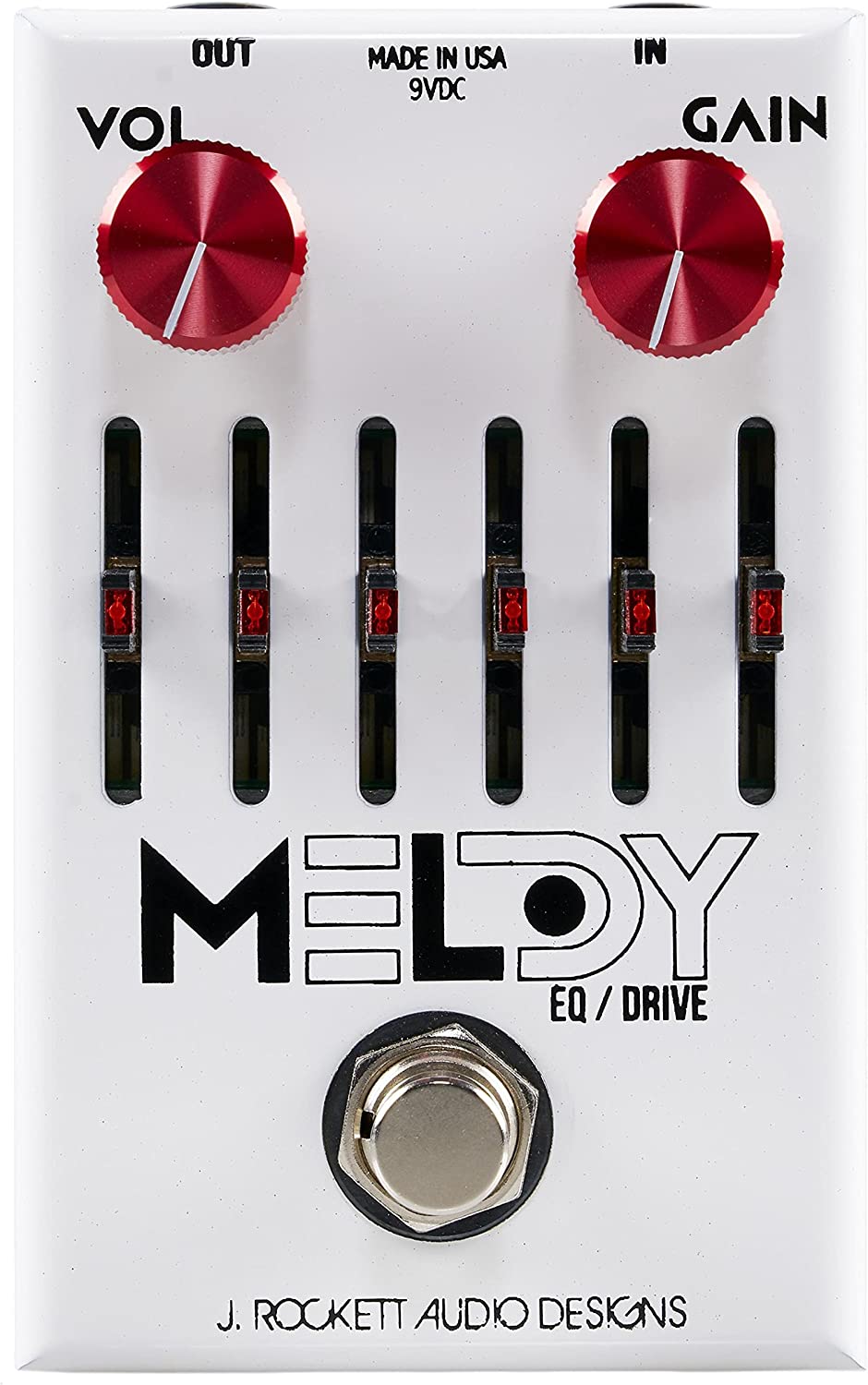
J.Rockett Audio Designs has created a dynamic effects pedal called the Q Series Melody Overdrive.
This is a guitar pedal that fuses an overdrive and a 6-band EQ, offering users a myriad of sound customization options.
You can use it as a basic EQ with volume control, sans gain, or gradually introduce various gain levels to fit your musical style.
The Melody Overdrive is a signature design of Mark Lettieri, providing a versatile overdrive that can cover a broad spectrum from jazz to rock tones.
It’s designed to enhance your rhythm and solo tone, promising an enriching playing experience.
What makes this red and white pedal unique is its six-frequency sliders.
Each one allows for an 18db cut or gain adjustment, offering precise control over your sound.
Measuring 5 x 2 x 3 inches and weighing one pound, it’s a handy companion on stage or in the studio.
- My Review
Let me dive right in by saying the J.
Rockett Audio Designs Q Series Melody Overdrive and 6-Band EQ Guitar Effects Pedal is one enchanting piece of hardware.
Compact in size and weight, it’s designed to make a big impact on your sound without being a burden on your gear load-out.
Once you plug this baby in, the possibilities unfold like sonic origami.
It smoothly integrates an overdrive and a 6-band EQ into one unit, offering a two-for-one deal.
I had the flexibility to use it as a standalone EQ or to mix in varying levels of gain to create a sound that suited my style.
When I played with the gain, the pedal retained its musicality across the range, feeling like a natural tube overdrive, complete with sag and thump.
Moving onto the frequency sliders, each offers an 18db cut or boost.
Imagine it like a palette with six shades of tone. You can blend in subtle nuances or dramatic shifts, depending on the sound you’re chasing.
Again, there was a sense of control and nuance that I thoroughly appreciated.
Taking the Melody Overdrive for a spin was akin to driving a finely-tuned sports car.
It allowed me to create tones from mellow jazz to edgy rock.
It’s like having a magic wand to elevate my rhythm and solo tone, adding a new level of depth and character to my playing.
However, despite its charms, there’s no denying that this pedal has a steep learning curve.
The sheer range of its EQ capabilities means it could take some time to fully understand how to leverage its full potential.
And, while the sliders allow for precise control, they felt somewhat delicate, which might not bode well with the heavy-footed among us.
Here are the ratings I’ll give to the J. Rockett Audio Designs Q Series 6-Band EQ Guitar Pedal:
I would describe this pedal as an ocean in a teacup. It’s small, but its depth of tone and flexibility is vast.
Yes, it requires some effort to explore its full depth, but isn’t that part of the thrill of sailing the seas of sound?
- Pros:
- Smooth overdrive for jazz to rock tones.
- Versatile EQ with 18dB cut or gain.
- Can be used as standalone EQ or with gain.
- Compact size (5 x 2 x 3 inches).
- Wide gain range with musical feel.
- Cons:
- Possible compatibility issues with other pedals.
- Occasional reports of loose input connection.
- Some users experienced jack problems.
My final verdict is that the J.Rockett Audio Designs Q Series Melody Overdrive and 6-Band EQ Guitar Effects Pedal is a highly versatile and feature-packed pedal with excellent tone and performance.
The positive reviews from users, its hand-built quality, and the reputation of the J.
Rockett Audio Designs brand makes it a solid choice for guitarists.
However, it is worth considering the occasional reports of compatibility issues with other pedals and the isolated incidents of loose input connection and jack problems.
Overall, it offers great value for its price and is recommended for those seeking a smooth overdrive and EQ solution for various musical styles.
Aguilar Tone Hammer Bass EQ Effect Pedal
Versatile bass preamp/direct box with 18V headroom and AGS.
Aguilar’s Tone Hammer pedal offers a preamp/direct box with fully sweepable midrange frequencies, Adaptive Gain Shaping circuitry, and 18 volt operation for dynamic playing styles. Its unique design also features a reduced “lip” and a flat surface, making it compatible with any right angle plugs and easy to mount on a pedal board.
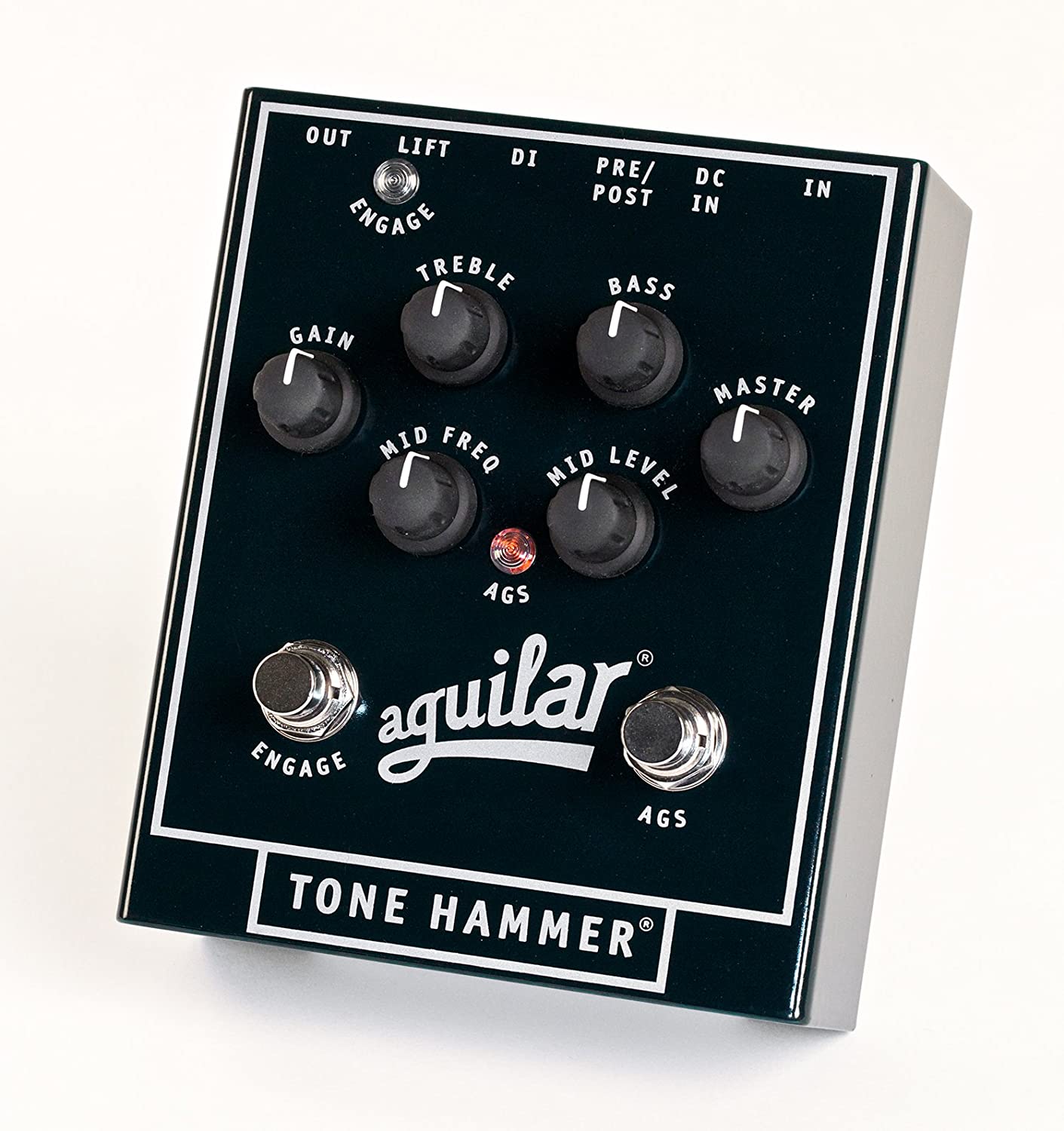
The Aguilar Tone Hammer Bass EQ Effect Pedal, known as the “Tone Hammer,” comes from Aguilar, a well-regarded brand in the world of music gear.
It’s essentially a preamp and direct box combined into one sturdy, black unit.
Its three-band EQ allows you to adjust the bass, midrange, and treble frequencies, offering a sweepable midrange and AGS (Adaptive Gain Shaping) circuitry.
As a result, it’s flexible for any bassist, letting you fine-tune your sound in a studio or live on stage.
You’ll find an unbalanced output capable of driving a power amp and an array of inputs and outputs for maximum connectivity.
It operates on two nine-volt batteries and supports phantom power or an optional universal power supply.
And get this: Aguilar has made their pedals smaller by reducing the outer edge, meaning it can accommodate any right-angle plugs, and it’s much easier to mount to a pedal board.
The Tone Hammer’s design measures a compact 5.37 x 4.5 x 2.62 inches and weighs a mere 1.62 pounds.
It’s a tool that’s as handy as it is powerful.
- My Review
Let’s discuss my experience with the Aguilar Tone Hammer Bass EQ Effect Pedal.
First, I was thrilled to see this thing built like a tank.
It has a smaller, more pedalboard-friendly design and boasts a black, sturdy casing that seems ready to endure the rigors of the road.
Upon plugging it in, I immediately noticed the versatility in tone shaping.
With the three-band EQ, I could dial in everything from subtle tone adjustments to aggressive EQ settings.
In addition, the sweepable midrange is a game-changer, allowing me to dial in my bass tone’s heart.
I also found the AGS circuitry interesting, adding an extra layer of gain and EQ when you want more oomph.
But it’s not all roses.
Although the AGS is a nice feature, it could use a bit of refining.
Engaging it added more volume than I was comfortable with, making it hard to use as an on-the-fly effect.
I also noticed the Tone Hammer’s faceplate overhangs a bit on the front and back, which adds unnecessary bulkiness.
Powering this pedal is quite flexible; I could run it on phantom power or two nine-volt batteries, which is a plus.
However, it didn’t come with a power cable and didn’t run on batteries as the description claimed, which struck me as odd.
Regarding connectivity, it provides an unbalanced output and inputs/outputs, offering great flexibility for various setups.
Regardless of the amp or mixer, I found the sound coming out of it consistently high-quality, which is a testament to its performance as a preamp and DI box.
Here are the ratings I’ll give to the Aguilar Tone Hammer Bass EQ Effect Pedal:
The Tone Hammer has its quirks, but its strengths still shine through.
All in all, I reckon it’s a solid addition to any bassist’s arsenal.
- Pros:
- Clear and punchy bass sound
- Footswitchable 3-band EQ with sweepable midrange
- AGS circuitry for additional gain and EQ options
- Can be powered by batteries, phantom power, or universal power supply
- Versatile for various setups and venues
- Cons:
- AGS distortion level not adjustable
- Output level control would be beneficial
- Slightly larger size compared to other pedals
- Two battery power system can be inconvenient
- No power cord included (requires separate purchase)
My final verdict is that the Aguilar Tone Hammer Bass EQ Effect Pedal is a highly capable and versatile tool for bassists.
It offers a range of features, including a foot-switchable 3-band EQ with sweepable midrange and AGS circuitry.
In addition, the pedal delivers a clear and punchy bass tone, making it suitable for various musical settings.
The brand, Aguilar, is well-regarded in the industry for producing high-quality bass equipment.
While there are some minor drawbacks, such as the non-adjustable AGS distortion level and the lack of an included power cord, the overall value and performance of the Tone Hammer are commendable.
Bassists looking for a reliable preamp/direct box with flexibility and excellent sound should consider the Aguilar Tone Hammer.
What exactly is an EQ pedal?
An EQ pedal, short for equalization pedal, is a fundamental tool in a musician’s arsenal, particularly for guitarists and bassists.
This kind of device manipulates the frequency spectrum of an audio signal to help shape the sound and tone of the instrument.
Its primary purpose is to adjust and fine-tune the tonal balance of an instrument or audio source, allowing musicians to emphasize or de-emphasize certain frequencies and harmonics.
The EQ pedal is a subset of the broader equalization technology used in music production and sound reinforcement.

However, it has specific characteristics and functionalities geared towards real-time, interactive use, which make it more suitable for musicians performing live or recording in a studio.
To understand how EQ pedals work, we need to delve a bit into the principles of sound.
A sound is a form of energy propagating through a medium (like air) as waves.
These waves have different frequencies, which we perceive as varying pitches.
The frequency of a sound wave is measured in Hertz (Hz), and the human ear can typically perceive frequencies ranging from 20 Hz to 20,000 Hz.
In musical terms, different frequencies correspond to different aspects of an instrument’s sound.
Lower frequencies (e.g., 20-200 Hz) correspond to bass sounds, mid-range frequencies (e.g., 200-2,000 Hz) represent the main body of most musical instruments, and higher frequencies (2,000-20,000 Hz) contribute to brightness and clarity.
By manipulating these frequencies, an EQ pedal can modify the character of an instrument’s sound, making it warmer, brighter, more or less resonant, etc.
EQ pedals come in various types, the most common being graphic and parametric EQs. A graphic EQ typically has fixed frequency bands that can be adjusted up or down using slider controls.
Each slider corresponds to a specific frequency, and moving it up boosts that frequency while moving it down cuts it.
This type of EQ is very intuitive and visual, hence the name “graphic.”
On the other hand, a parametric EQ provides more precise control.
It usually has fewer bands, but each band is adjustable in three ways: frequency, gain, and Q (bandwidth).
Frequency determines which center frequency to adjust, gain controls how much to boost or cut, and Q sets the range of frequencies affected around the center frequency.
This allows musicians to hone in on specific frequencies and shape their sounds with great detail.
EQ pedals can be used creatively to correct issues with an instrument’s sound.
For instance, an EQ pedal can cut some higher frequencies if an electric guitar sounds too harsh.
Or if a bass guitar lacks definition, boosting the mid-range frequencies can help it cut through the mix better.
Additionally, EQ pedals can mitigate feedback issues in live settings or adjust for room acoustics.
In a live performance setup, the EQ pedal is typically part of a pedalboard and can be placed in various positions in the signal chain, depending on the desired effect.
What to consider when choosing an EQ pedal?
Choosing an EQ pedal involves a complex array of factors.
Every musician has unique needs and preferences, so weighing the options carefully before settling on a specific pedal is crucial.
– Sound Quality
The sound quality is arguably the most important factor when choosing an EQ pedal.
The primary purpose of an EQ pedal is to manipulate and enhance the sound of your instrument, so you need to ensure it does this effectively and cleanly without introducing unwanted noise or distortion.
Different EQ pedals may emphasize different frequencies or offer varying levels of precision, so it’s worth trying out a few to see which one gives you the sound you’re looking for.
Of course, you want an EQ pedal that can bring out the best in your instrument, whether trying to emphasize the warmth of an acoustic guitar, the growl of a bass, or the bite of an electric guitar.
– Controls and features:
EQ pedals come with various controls and features, depending on their type and design.
For example, graphic EQs typically offer sliders for each frequency band, making them intuitive and visual, while parametric EQs offer more precise control with adjustable frequency, gain, and Q settings.
The number of bands is another significant feature to consider.
More bands allow for finer control over the sound, making the pedal more complex to operate.
A pedal with more bands might be suitable if you require detailed sound shaping.
However, for basic tonal adjustments, a simpler model may suffice.
– Analog vs. digital
Whether to choose an analog or digital EQ pedal is a matter of personal preference.
Analog EQs offer a warmer, more organic sound, while digital EQs offer greater precision and versatility, with features like frequency analyzers and preset storage.
Analog EQs use physical components to process the signal, which some musicians feel results in a richer, more natural sound.
Digital EQs, on the other hand, convert the signal into digital data to be processed.
This allows for more complex and precise equalization, but some purists argue it can make the sound somewhat sterile.
– Build quality and durability
Whether you’re gigging regularly or using your EQ pedal in a home studio, build quality and durability are important considerations.
A pedal built to last will stand up to the rigors of regular use and ensure consistent performance.
Look for a pedal with a sturdy, rugged construction.
Metal chassis is more durable than plastic ones, and high-quality switches and connectors will ensure reliable operation.
Also, consider the layout and design: the controls should be robust, easy to operate, and not prone to accidental adjustments.
– Presets and versatility:
If you play a variety of styles or frequently need to adjust your sound to suit different songs, an EQ pedal with presets can be incredibly useful.
These allow you to store specific settings and recall them at the press of a button.
Some EQ pedals also offer additional features that increase their versatility, such as dual channels for separate EQ settings or integrated tuner or boost functions.
Consider your specific needs and how these additional features might benefit you.
– Brand reputation
The reputation of the brand is another factor to consider.
Reliable brands typically offer better customer support, more reliable performance, and more durable products.
In addition, look for brands with a proven track record in the industry and positive feedback from users.
However, brand reputation shouldn’t be the only factor you consider.
Some lesser-known brands offer excellent products at competitive prices, so don’t rule out an EQ pedal because it’s not from a big-name brand.
– Price and budget
Price is an unavoidable factor in any purchase.
High-end EQ pedals often offer superior sound quality, more features, and better build quality, but they also come with a higher price tag.
Setting a realistic budget based on your needs and financial situation is important.
You don’t need to spend a fortune to get a good EQ pedal, but it’s worth investing in a quality product that will serve you well for years.
– Reviews and recommendations
Lastly, don’t underestimate the power of reviews and recommendations.
Reading reviews can give you a sense of the strengths and weaknesses of different EQ pedals and how they perform in real-world scenarios.
Recommendations from other musicians, whether in person or on forums and social media, can also be a valuable source of information.
People who have used the pedal in a similar context can provide insights you might not find elsewhere.
How to properly use an EQ pedal?
When molding and refining the tonal palette of your guitar sound, using an EQ (Equalizer) pedal can be a game-changer.
The EQ pedal, an under-appreciated yet versatile device in the guitarist’s arsenal, allows the player to alter specific frequency bands, offering far more precision than traditional tone knobs.
However, as with any specialized tool, its potency lies in its proper use.
This guide will delve into correctly utilizing an EQ pedal.
This information will help novices and experienced players fine-tune their sound to their preference, ensuring they can express their musical ideas as envisioned.
– Familiarize yourself with the controls and features
The first step in using an EQ pedal properly is understanding its controls and features.
Most EQ pedals have a series of bands or sliders, each corresponding to a specific frequency range.
Moving a slider up boosts that frequency, and moving it down reduces it.
If you’re working with a parametric EQ, you’ll also have controls for selecting the center frequency and adjusting the Q or bandwidth.
Some models also include level controls for overall volume adjustment.
Take the time to understand what each control does and how it affects your sound.
Then, refer to the user manual for instructions and details about your pedal.
– Adjust the parameters to suit your musical goals
To get the most out of an EQ pedal, you must adjust its parameters based on your musical objectives.
Want to add some warmth to a sterile-sounding guitar?
Boost the low-mid frequencies.
Do we need to give a muddy mix more clarity?
Increase the high frequencies slightly.
Is your guitar feeding back on stage?
Try cutting the specific frequency that’s causing the problem.
Remember, every instrument, amplifier, and room is different, so what works for one situation may not work for another.
– Incorporate the EQ pedal into your signal chain
Placement of the EQ pedal in your signal chain can significantly impact its effectiveness.
If placed at the beginning, it will affect the raw sound of your instrument, shaping its tone before other effects modify it.
If placed after the distortion or overdrive pedals, it can alter the character of the distorted sound.
Finally, near the end of the chain, it can serve as a final tone-shaping tool before the signal reaches the amplifier.
Experiment with different placements to find what works best for you.
– Experiment with different EQ settings
Different genres and playing styles demand distinct techniques and approaches and require unique tonal qualities that complement the music’s vibe and sound.
The tonal quality is essential in creating the right atmosphere and emotion, setting the music’s character.
For instance, a jazz guitarist might desire a warm, rounded tone that gives off a smooth and sultry feel, perfectly suited for the intricacies and complexities of jazz music.
This tone can be achieved by adjusting the EQ settings, emphasizing the mid and low frequencies, while dialing back on the treble.
On the other hand, a metal player craves a tight, aggressive sound that packs a punch and delivers the raw energy associated with heavy and powerful riffs.
This can often be accomplished using high gain, scooped mids, and an emphasis on the low-end and treble frequencies.
To find the ideal tonal qualities for different musical styles, a guitarist should not hesitate to experiment with the EQ settings on their EQ pedal.
By adjusting the bass, mid, and treble frequencies, it is possible to carve out unique and genre-specific tones that enhance the overall sound of the performance.
Furthermore, some EQ pedals can save custom presets or patches.
This feature can be extremely helpful for guitarists who frequently switch between various styles, as it allows them to quickly recall their favorite EQ settings and tonal configurations with the press of a button.
– Understand the impact of the EQ pedal on your tone
The EQ pedal plays a significant role in fine-tuning and sculpting your tone, but it is imperative to remember that just one piece of the puzzle contributes to your final sound.
Several other factors contribute to your overall sound and tone, and it’s essential to consider these variables when adjusting your EQ pedal settings.
Some of these include:
Guitar pickups: Your choice of pickups on your guitar can dramatically affect your tone.
Single-coil pickups often produce a brighter, more trebly sound, while humbucker pickups provide a thicker, warmer tone.
Consider how the inherent characteristics of your pickups will interact with your EQ pedal settings and make adjustments for a balanced and complementary tone.
Amplifier: Different amplifiers have their unique tonal qualities and characteristics.
Some amplifiers are well-known for their warm, mid-focused sound, while others are renowned for their sparkling, high-end clarity.
Remember how your amplifier’s natural tone will interact with your EQ pedal settings and adjust accordingly to create a coherent and harmonious sound.
Room acoustics: The acoustics of the room you’re playing in can significantly affect your perceived sound.
A room with many hard surfaces and little furniture may increase the prevalence of high frequencies and create a brighter sound, while a room with carpeting and more furnishings will likely absorb high-end tones and produce a more subdued, muffled sound.
Adjust your EQ settings to compensate for the room’s acoustics, and aim for a balanced sound in your specific environment.
Effect pedals: If you’re using other effect pedals in your signal chain, be aware of how they might interact with your EQ pedal.
Many pedals, like overdrives, distortions, or compressors, can influence your tone, so experiment with the order of your pedals and how their settings affect your overall sound when combined with the EQ pedal.
– Learn when to engage and disengage the pedal
Utilizing an EQ pedal effectively goes beyond merely adjusting the settings and letting it run throughout the performance.
Engaging and disengaging the EQ pedal at strategic moments can add dynamic interest, enhance your sound, and contribute to a captivating performance.
Here are some situations where turning your EQ pedal on and off can make a difference during a performance:
Guitar solos: When it’s time for a guitar solo, engaging the EQ pedal to boost specific frequencies can help your guitar stand out.
For example, increasing the mid-range frequencies can give your guitar a more prominent voice, ensuring that your solo slices through the rest of the band and captures the audience’s attention.
Rhythm vs. lead playing: If you’re alternating between rhythm and lead playing duties within a song, consider engaging the EQ pedal for different sections.
This can help clarify and distinguish your roles and add contrast to the performance.
For instance, you can boost the treble or mid-range frequencies while playing lead and then disengage the pedal during rhythm parts for a more balanced mix.
Preventing feedback: If you’re experiencing issues with feedback during live performances, using your EQ pedal to cut problematic frequencies can help mitigate the problem.
Experiment with reducing specific frequencies that tend to cause feedback in your guitar, amp, or PA system setup, and only engage the EQ when feedback becomes an issue.
Creating contrast: To add interest and variety to your performance, engage and disengage the EQ pedal between different songs or sections of a song.
For instance, you could use the EQ pedal to dial in a darker, more subdued tone for a slow ballad and bypass the pedal for a brighter, more energetic tone during upbeat songs.
Boosting volume: If your EQ pedal features a level control, you can use it as a volume boost for specific performance parts.
Engaging the pedal with a higher-level setting can provide emphasis during song intros, choruses, or solos, creating a dynamic and engaging performance.
Developing a sense for when to make EQ adjustments and not being afraid to experiment with engaging and disengaging the pedal on the fly will greatly enhance your live performances.
– Regularly maintain and clean it to ensure optimal functionality
Like any equipment, an EQ pedal needs regular maintenance to perform its best.
You should keep it clean and dust-free, and check the connections and controls regularly to ensure they’re functioning correctly.
If your pedal is battery-powered, check the battery regularly and replace it as necessary.
By doing things every now and then, you can make sure that it will properly work at all times.
And by the way, this also applies to your other pedals, so make sure you take care of those as well.
How to order pedals on a pedalboard?
There is no one-size-fits-all approach to ordering pedals on a pedalboard, as the optimal arrangement largely depends on the specific sound you’re aiming for.
Usually, though, you will see guitar players mostly agreeing with this order:
Tuner > Filters/Dynamics > Pitch-based Effects > Overdrive/Distortion > Modulation > Time-based Effects > Looper
Aside from that, some general guidelines can help you achieve a balanced and versatile setup.
Let’s talk in detail about the order we just mentioned, but feel free to experiment and adjust to your own preferences:
- Tuner: Place your tuner pedal first to ensure your signal is in tune before passing through the other pedals.
- Filters and dynamics: Wah-wah, envelope filters, compressors, EQs, and noise gates should come next. These pedals affect your sound’s dynamic and tonal aspects, so it’s best to place them early in the chain.
- Pitch-based effects: Octavers, harmonizers, and pitch shifters should come after filters and dynamics since these pedals alter the pitch of your signal and work best with a clean, unprocessed sound.
- Overdrive and distortion: Overdrive, distortion, and fuzz pedals typically come next. They shape your guitar’s core sound, and placing them before most other effects ensures that those effects receive a strong, consistent signal.
- Modulation effects: Chorus, flanger, phaser, and tremolo pedals should be placed after overdrive and distortion effects. We do this to allow these pedals to add depth and movement to your sound without becoming overly distorted or overbearing.
- Time-based effects: Delay and reverb pedals should be placed towards the end of your signal chain. This allows them to create a sense of space and depth around the other effects, simulating the sound of a room or hall.
- Looper: If you use a looper pedal, it should be placed last in the chain. This ensures that you’re looping the entire signal, including all the effects you’ve applied.
Remember, these are just general guidelines and what generally works and sounds good.
The most important thing is to experiment and find the arrangement that best suits your personal sound and style.
For example, here’s one pedalboard signal chain that I always use:
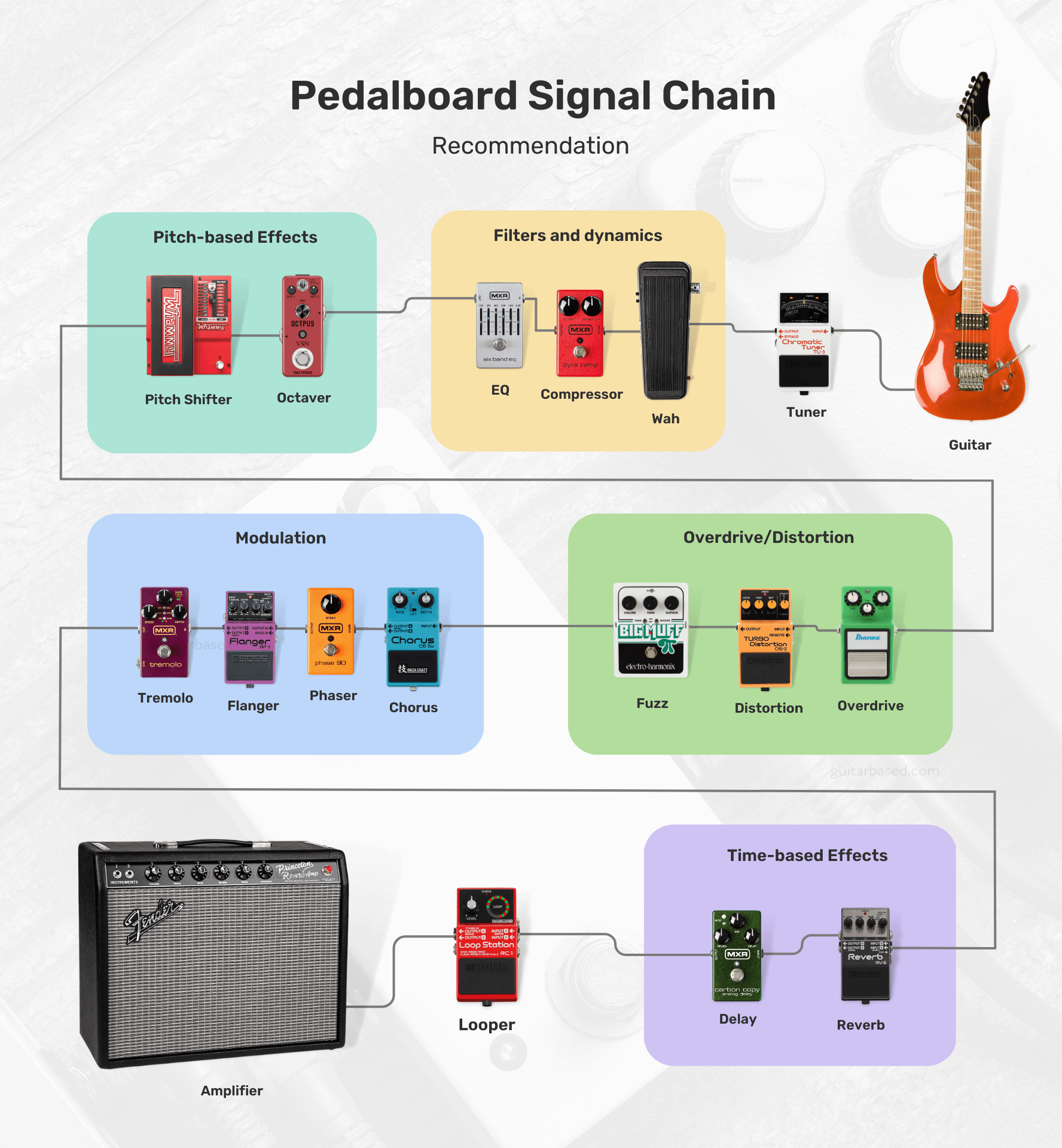
Feel free to swap the order of pedals, try different combinations, and test out unconventional setups until you find the one that works best for you.
For those interested, I’ll leave you with most of the possibilities that you’ll encounter and how to order them.
- Tuner
- Filters/Dynamics:
- Volume
- Wah
- Auto-Wah
- Compressor
- Noise Gate
- EQ (Equalizer)
- Pitch-based Effects:
- Octaver
- Harmonizer
- Pitch Shifter
- Overdrive/Distortion/Fuzz:
- Boost
- Overdrive
- Distortion
- Fuzz
- Modulation:
- Chorus
- Phaser
- Flanger
- Univibe
- Vibrato
- Tremolo
- Time-based Effects:
- Delay
- Echo
- Reverb
- Synth/Bitcrusher:
- Synth
- Bitcrusher
- Acoustic Simulator
- Multi-Effects
- Utility:
- Buffer
- A/B/Y Switcher
- MIDI Controllers
- Looper
Boutique vs. Mass-Produced pedals
Boutique pedals are generally built with higher-quality components and craftsmanship, resulting in better durability and longevity.
These pedals often feature unique and innovative designs, providing a wider range of tones and effects that may not be available in mass-produced options.
Here are a few examples of boutique pedals:

All the manufacturers also tend to have a more personal approach, with better customer service and the ability to customize pedals according to the user’s preferences.
However, boutique pedals are usually more expensive due to the smaller scale of production and the use of premium components.
Mass-produced pedals, on the other hand, are more affordable due to their larger scale of production and the use of cost-effective components.
These pedals are widely available and offer a range of popular effects, making them accessible to a larger audience.
Here are a few examples of mass-produced pedals:

The quality control for mass-produced pedals can vary depending on the brand and model, but many are reliable and offer good value for the money.
As for one of the downsides, you’ll find that mass-produced pedals may not have the same level of uniqueness or innovation as boutique options.
On the other hand, they may not provide the same level of customer service or customization options.
The choice between boutique and mass-produced pedals depends on your personal preferences, budget, and desired sound.
If you’re looking for unique tones, higher-quality components, and a more personal experience, boutique pedals may be the way to go.
But I would say, for those who are on a budget and need access to popular effects, mass-produced pedals might be a better fit.
It’s worth trying out both types to see which best suits your needs and playing style.
How much should you spend on a guitar pedal?
If I were in your position, I would first determine my budget and specific needs before deciding how much to spend on a guitar pedal.
For beginners, it might be more reasonable to start with affordable, mass-produced pedals to explore different effects without spending too much.
Guitar pedals can range in price from around $30 to over $400, depending on the brand, quality, and complexity of the effect.
As your skills and understanding of your preferred tone develop, you can gradually upgrade to higher-quality or boutique pedals.
One thing I would do is consider which effects are essential to your playing style and prioritize purchasing those first.
Allocating a larger portion of your budget to the most important pedals might be a wise choice, especially if you only need a few basic effects.
However, if you require a wide array of effects, you may want to consider more budget-friendly options or multi-effects units.
Keep in mind that higher-priced pedals often come with better build quality, unique features, and improved sound quality.
But I would also say that price is not always directly correlated with quality or suitability for your needs.
Sometimes, a more affordable pedal can deliver the exact sound you’re looking for, while a higher-priced option might not meet your expectations and are only expensive because of the brand reputation.
Can you use a guitar pedal with a bass guitar?
You can certainly use a guitar pedal with a bass guitar.
But it’s crucial to be aware that some guitar pedals may not be specifically designed to accommodate the frequency range of a bass guitar.
This could result in a less-than-ideal performance or an altered tone that might not be what you were expecting.
If you’re feeling adventurous and eager to experiment with your sound, don’t hesitate to connect your guitar pedals to your bass guitar.
This can be a fun way to explore different sonic possibilities, and you might even stumble upon some unique tones that complement your playing style perfectly.
Using a guitar pedal with a bass guitar may not always produce the desired results.
In some cases, the low-end frequencies might be lost, or the effect could sound too harsh or muddy.
To avoid these issues, you could consider looking into pedals that are specifically designed for bass guitars.
These pedals are engineered with the bass frequency range in mind, ensuring that your low-end remains intact and the effect sounds as intended.
In addition to bass-specific pedals, there are also multi-effects processors and pedals that cater to both guitar and bass players, offering a wide range of effects and tonal options.
These versatile units can be a great solution if you play both instruments and want a single device to cover your needs.
How to properly power your pedals?
When it comes to powering your pedals, you want to make sure you’re doing it right to avoid any noise issues or potential damage.
First, check each pedal’s power requirements, which you can usually find in the manual or on the pedal itself.
You’ll want to pay attention to the voltage (usually 9V, 12V, or 18V) and current (measured in milliamps or mA).
Now, you’ve got a few options for powering your pedals.
You can use individual power supplies or batteries for each pedal, but that can get messy and inconvenient.
I’d recommend going for a pedal power supply or an isolated power brick.

For example here are a few ones I recommend:
- Voodoo Lab Pedal Power 2 Plus Isolated Power Supply (My favorite)
- Rowin PW-1 Guitar Pedal Power Supply (Cheapest)
These babies can power multiple pedals at once, and the isolated outputs help prevent noise and ground loop issues.
Just make sure the power supply you choose can handle the voltage and current requirements of all your pedals.
When you’re connecting everything, use good quality power cables and keep them neat and tidy to avoid a tangled mess.
You might even want to use cable ties or cable organizers to keep everything in order.

More than 10 years of experience playing and writing about guitars! When not writing, I can be found strumming away some Johnny Cash tunes. Favorite all time guitar is the Gibson Les Paul. #TeamGibson

